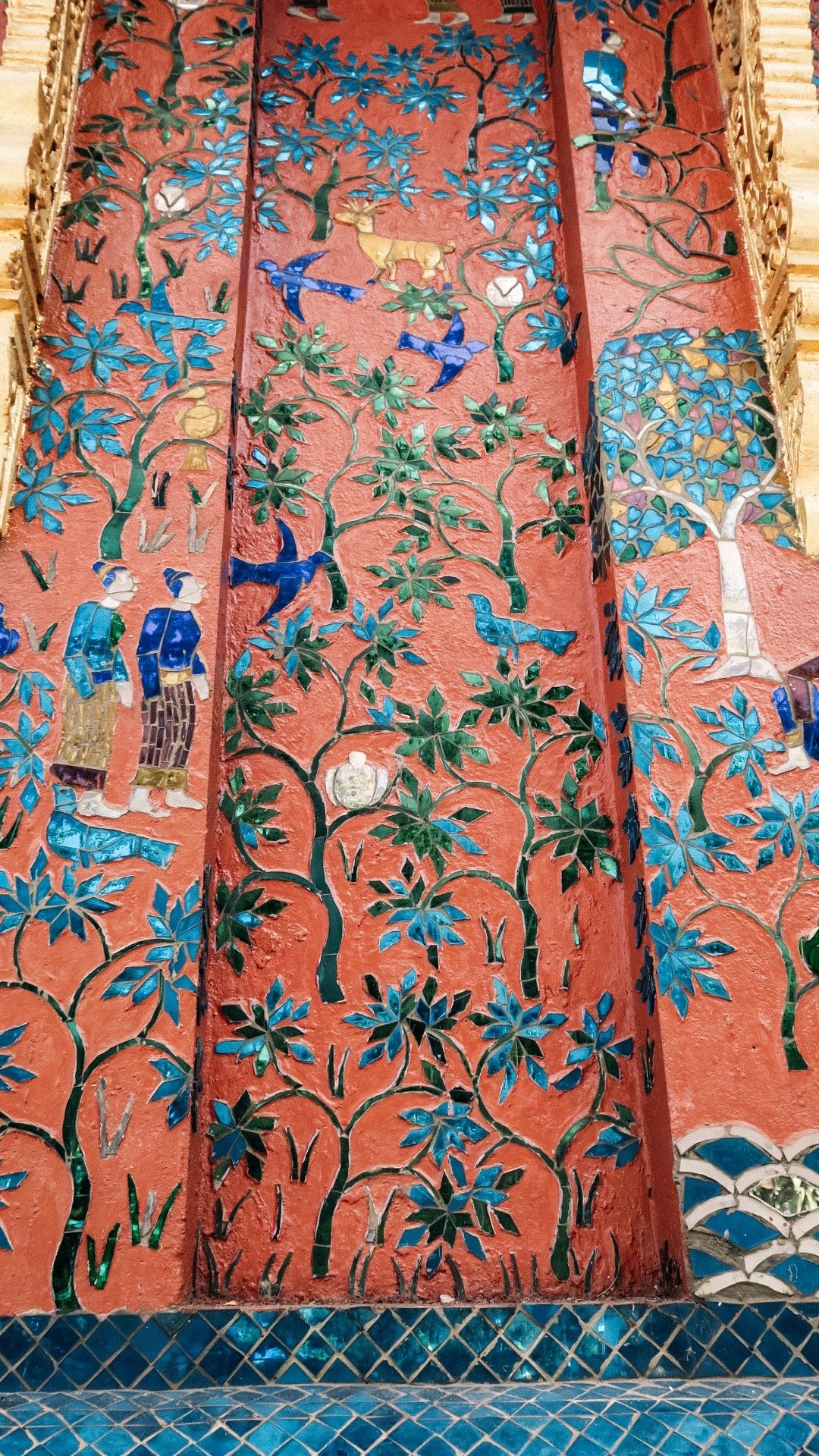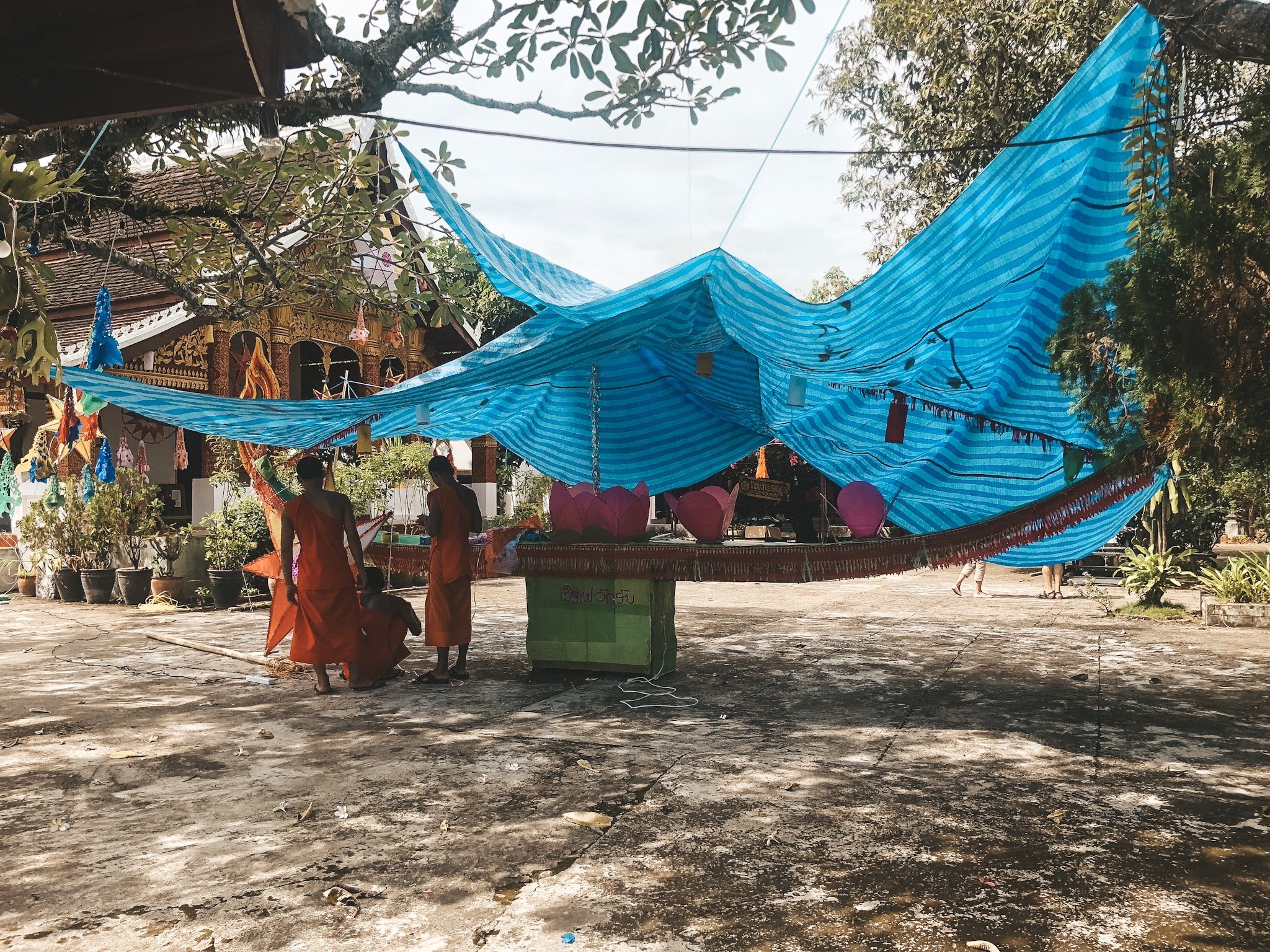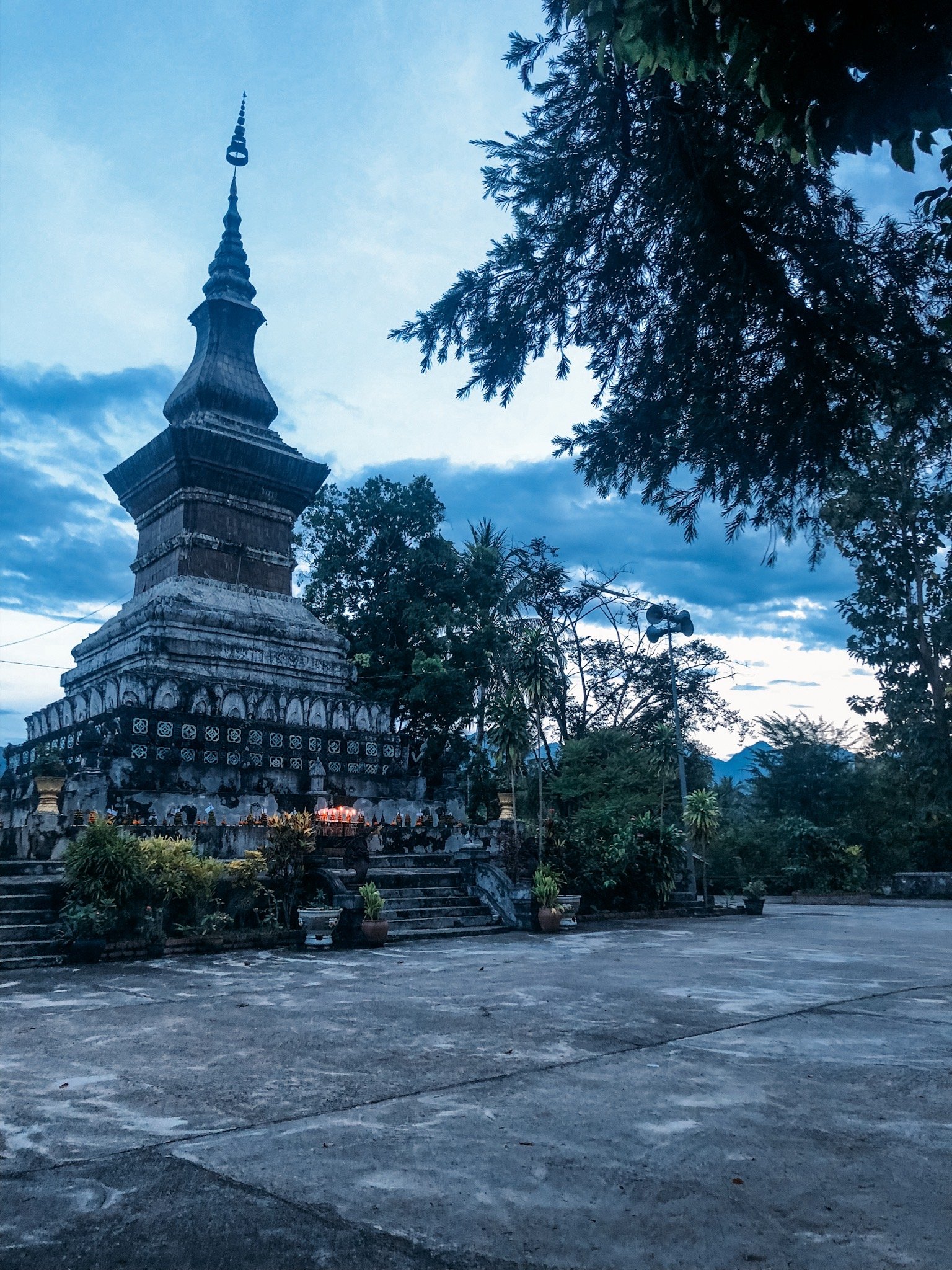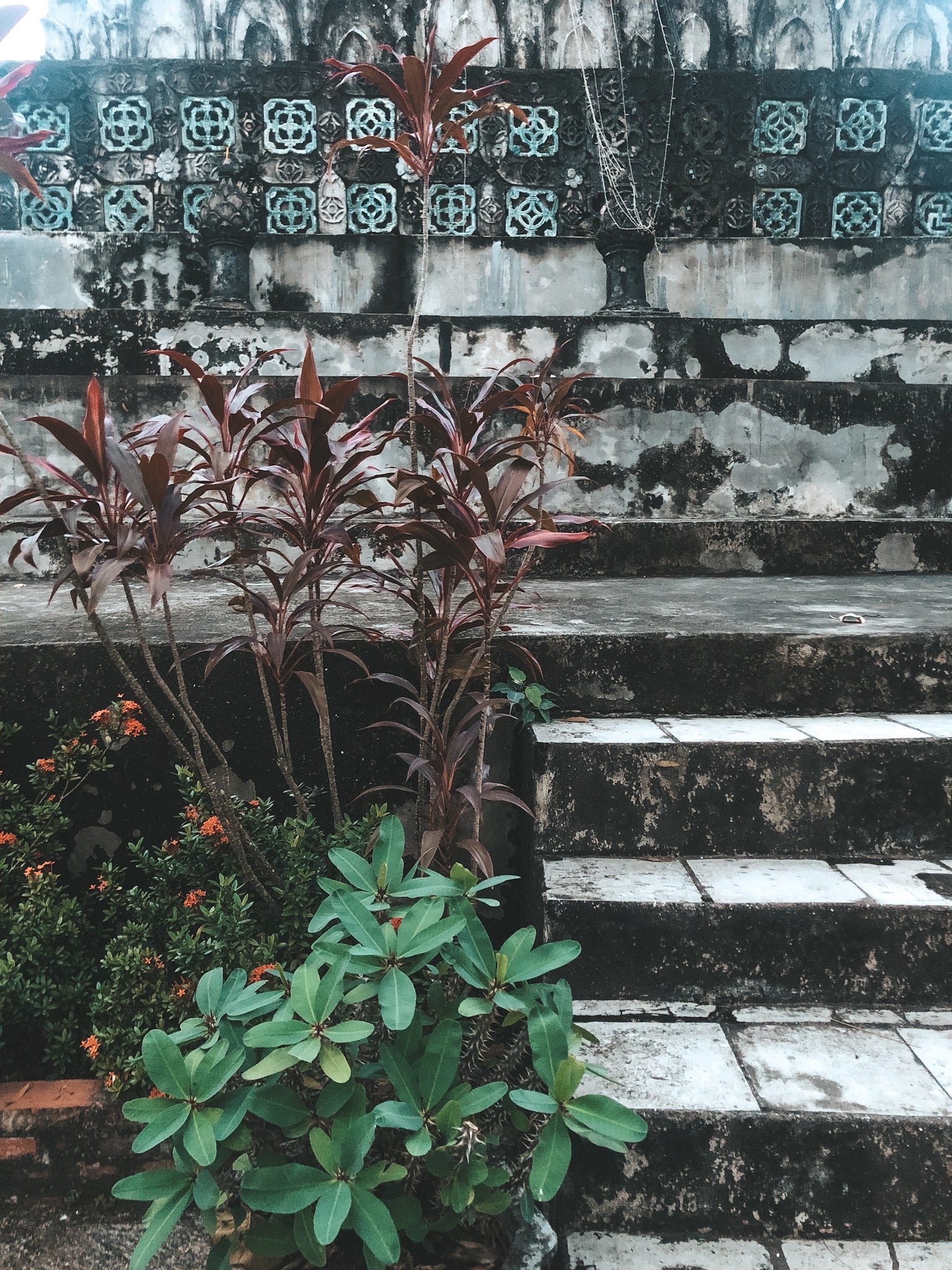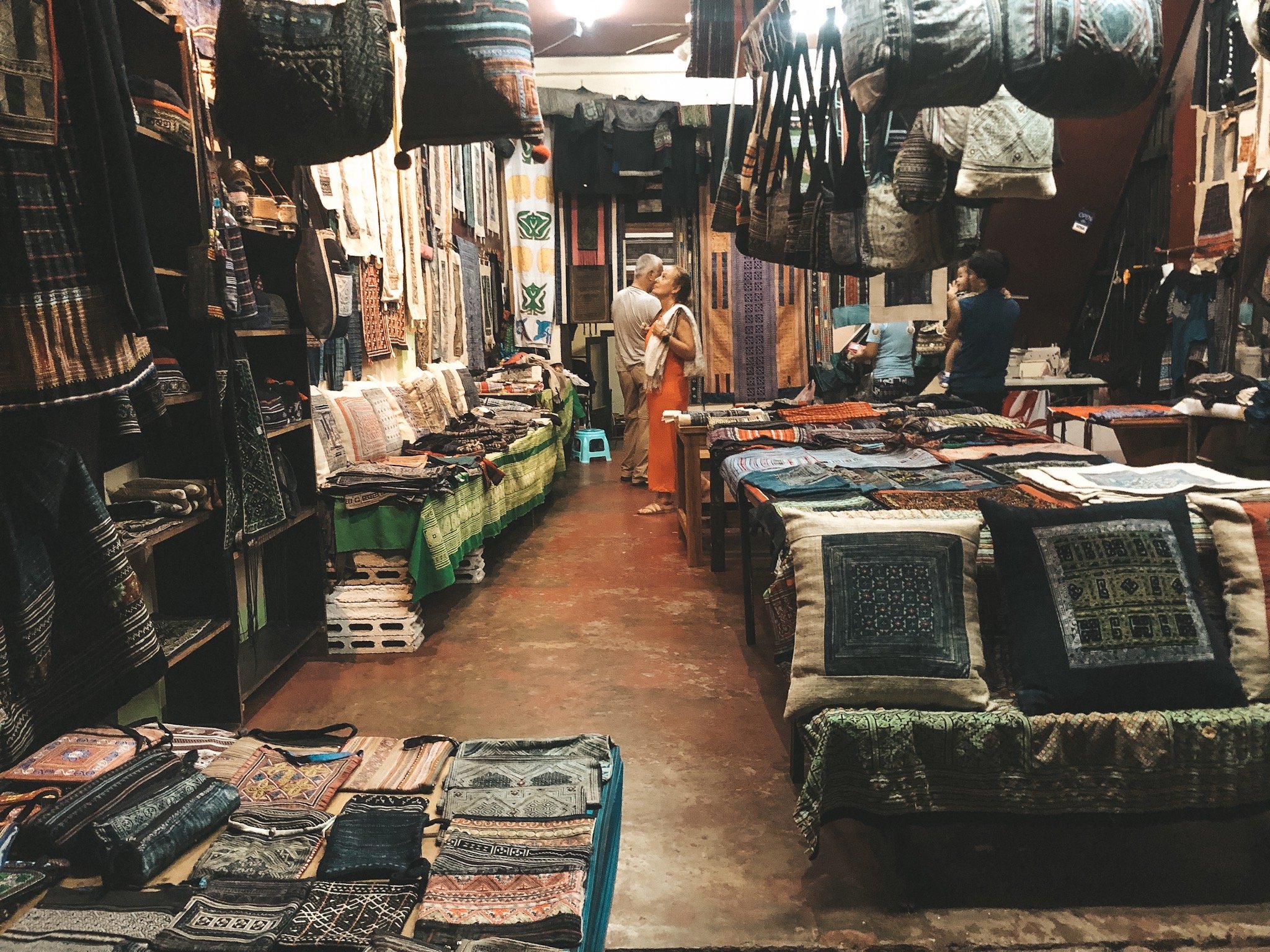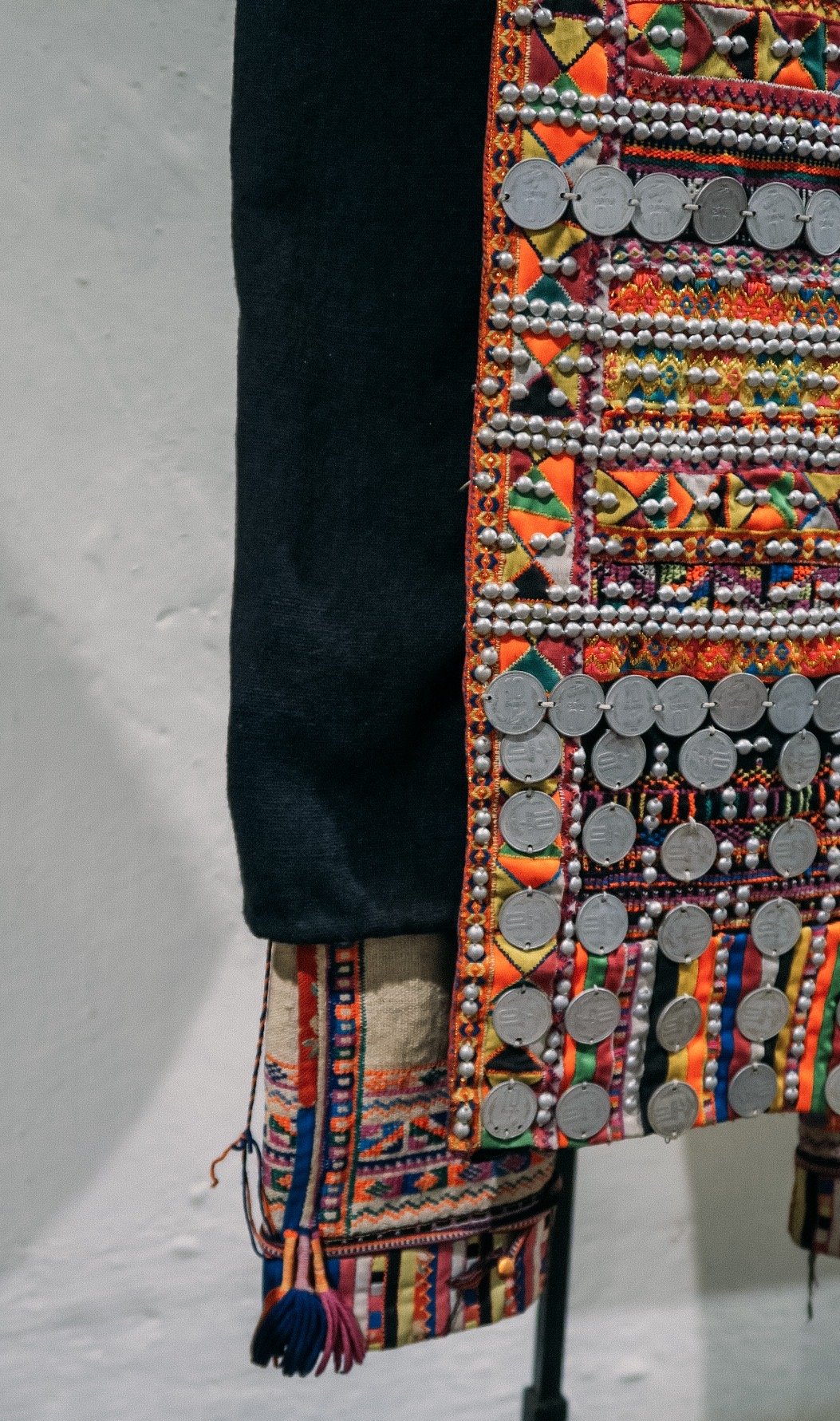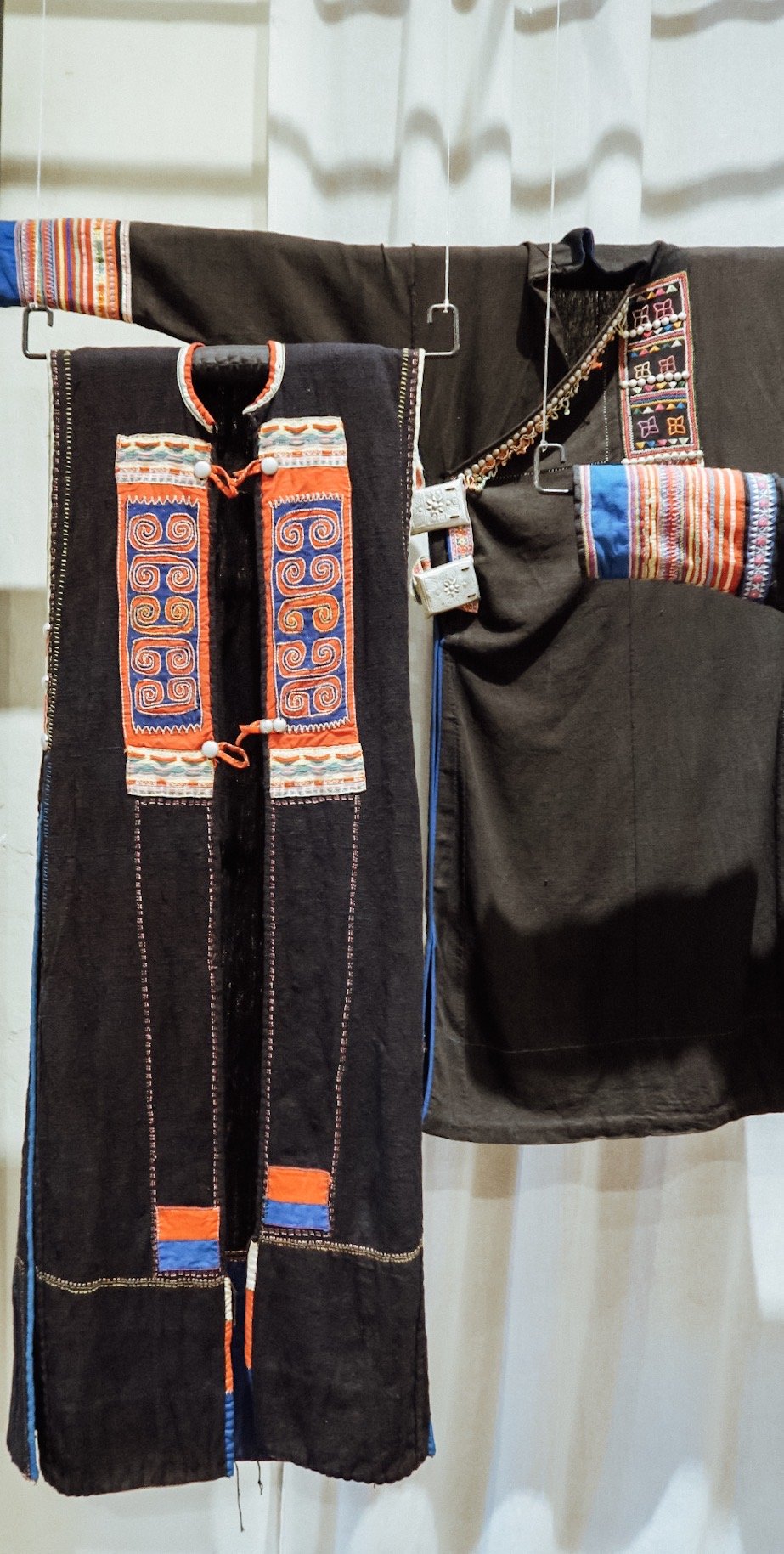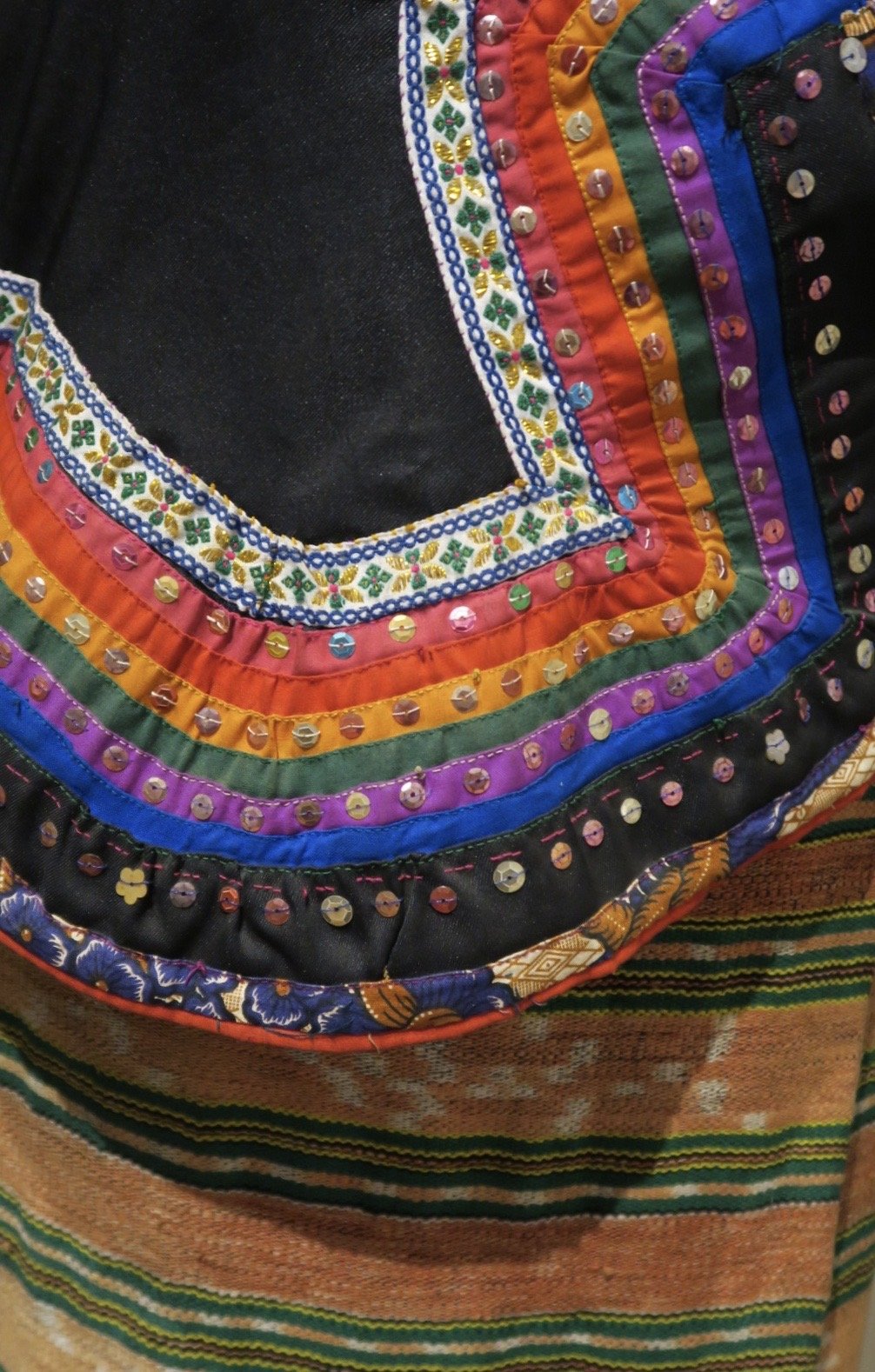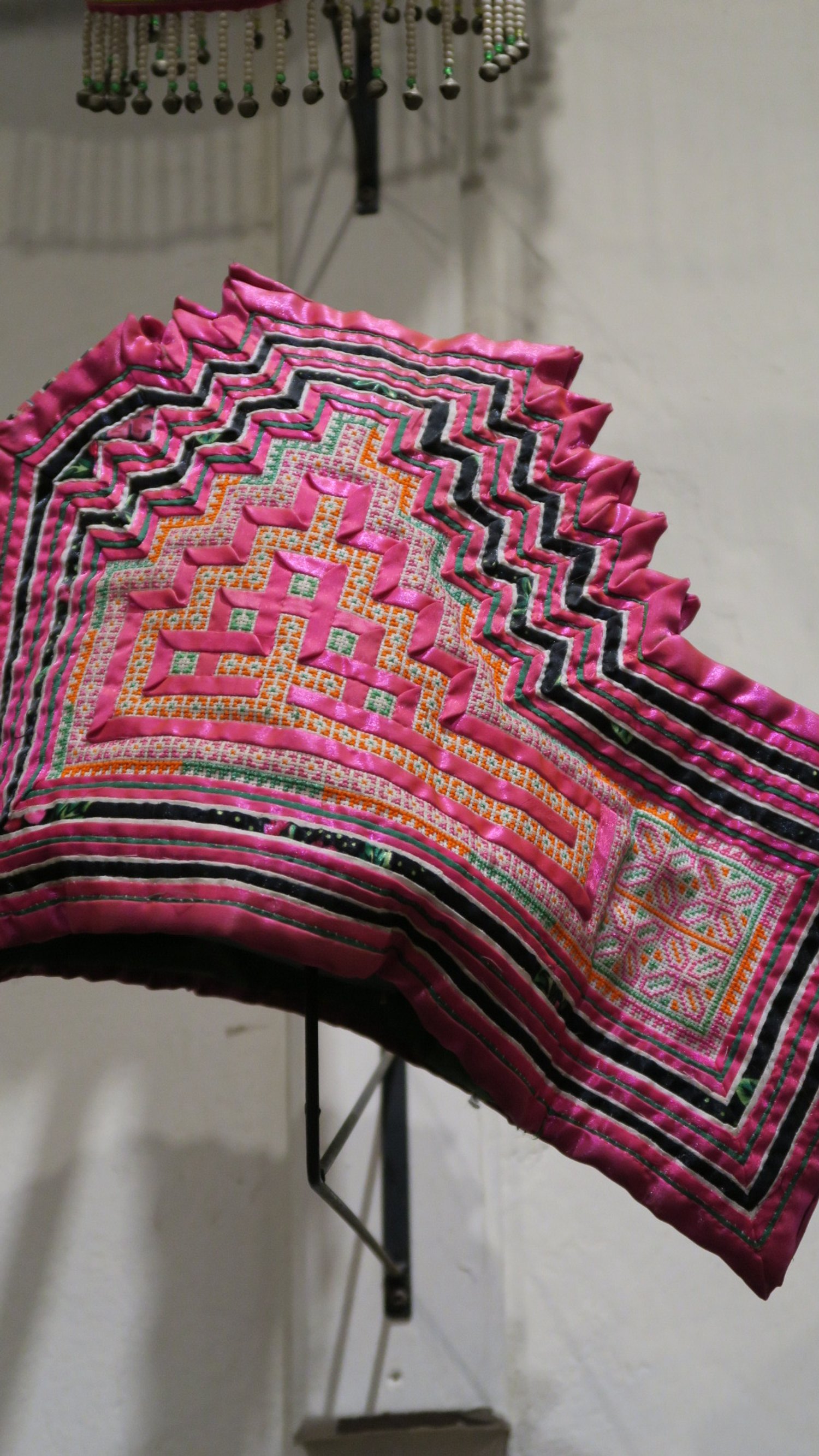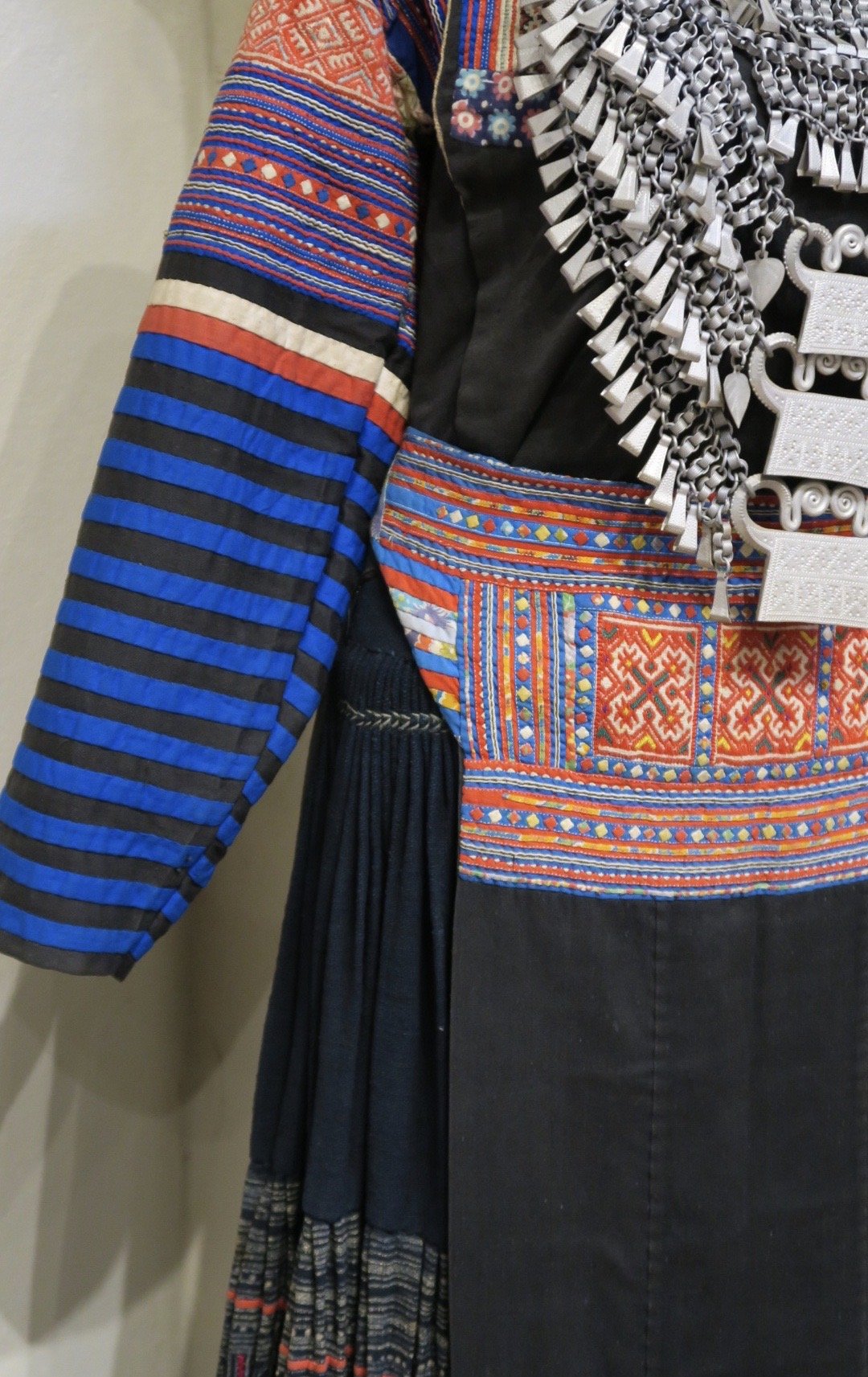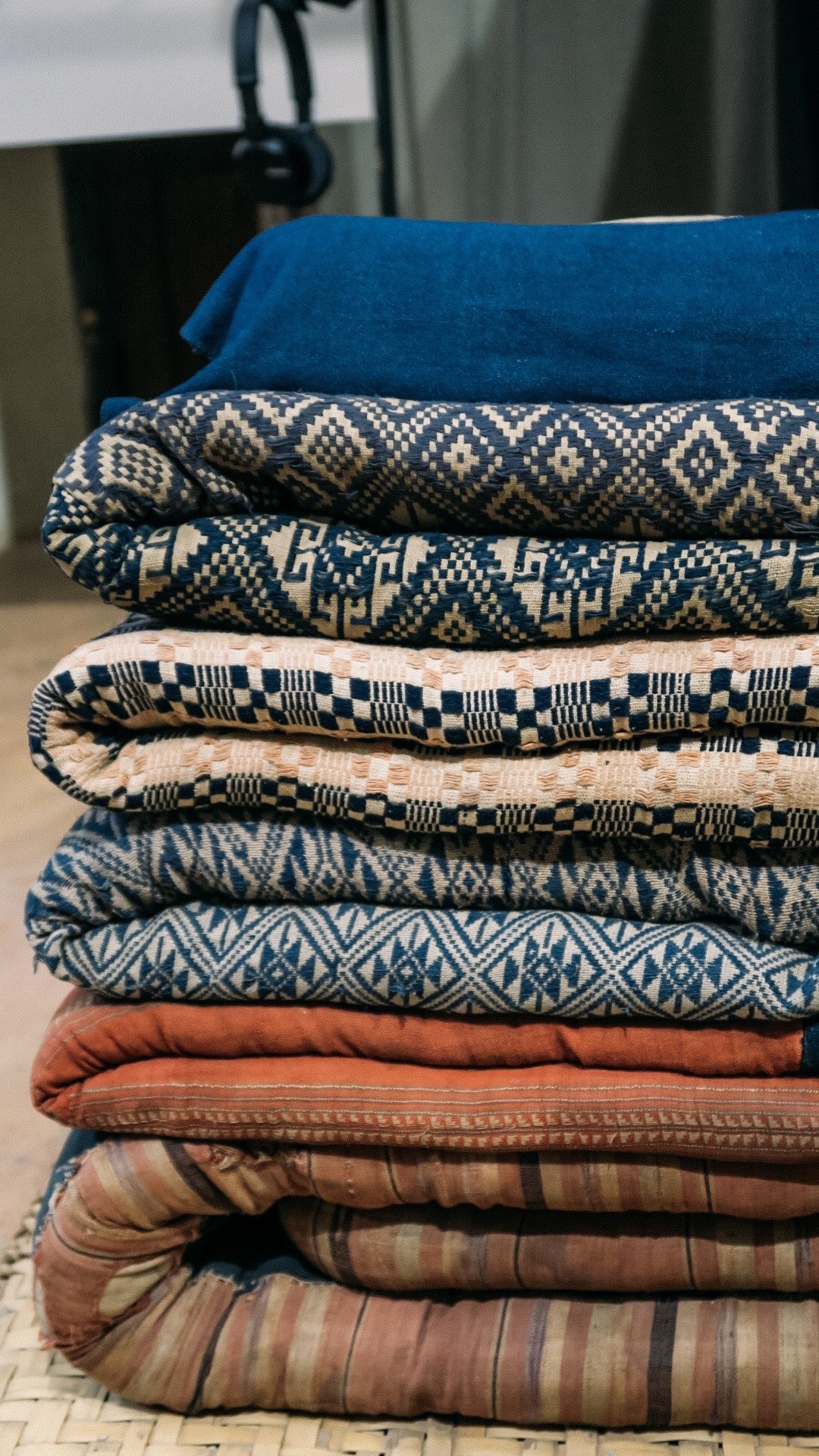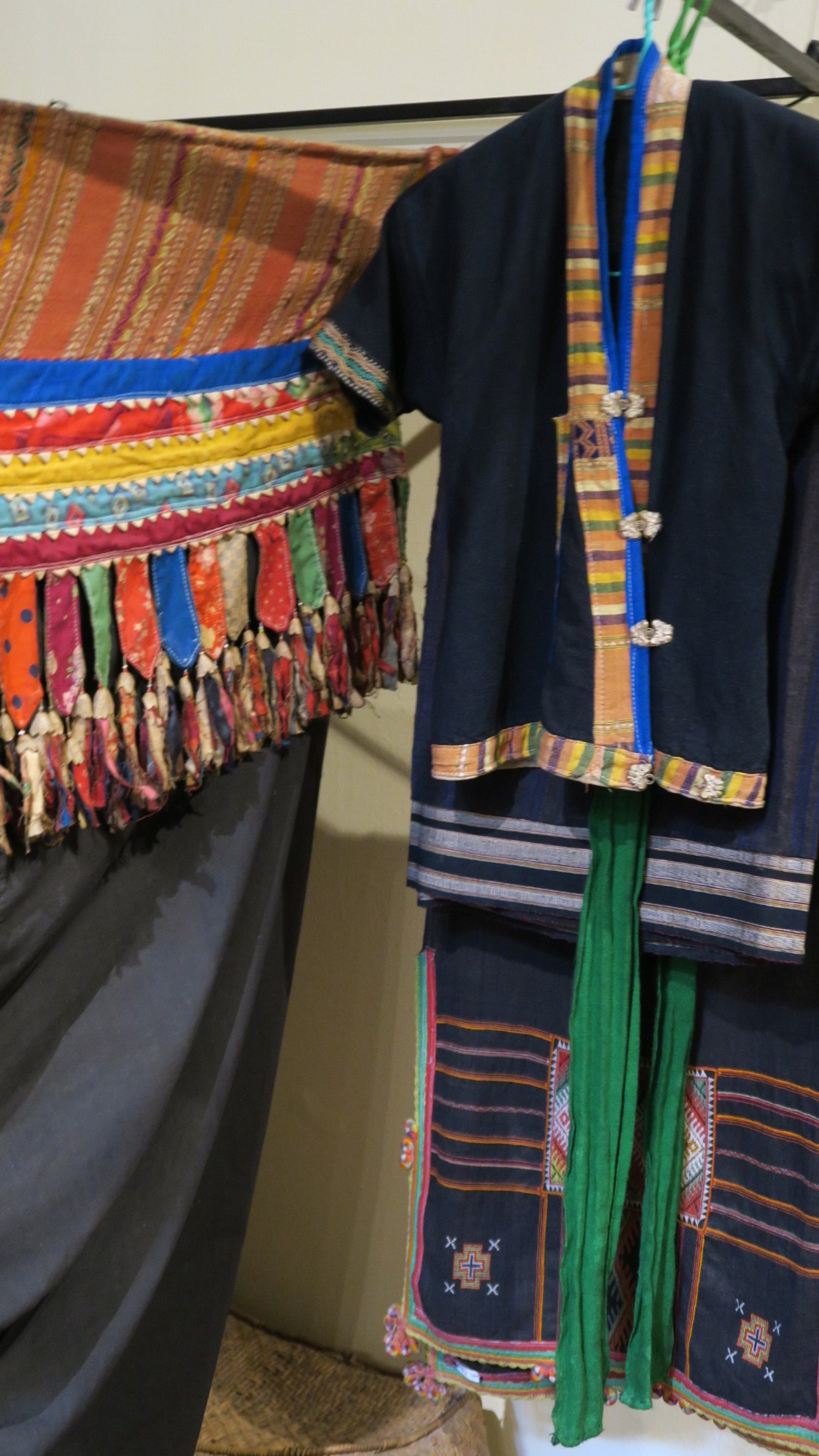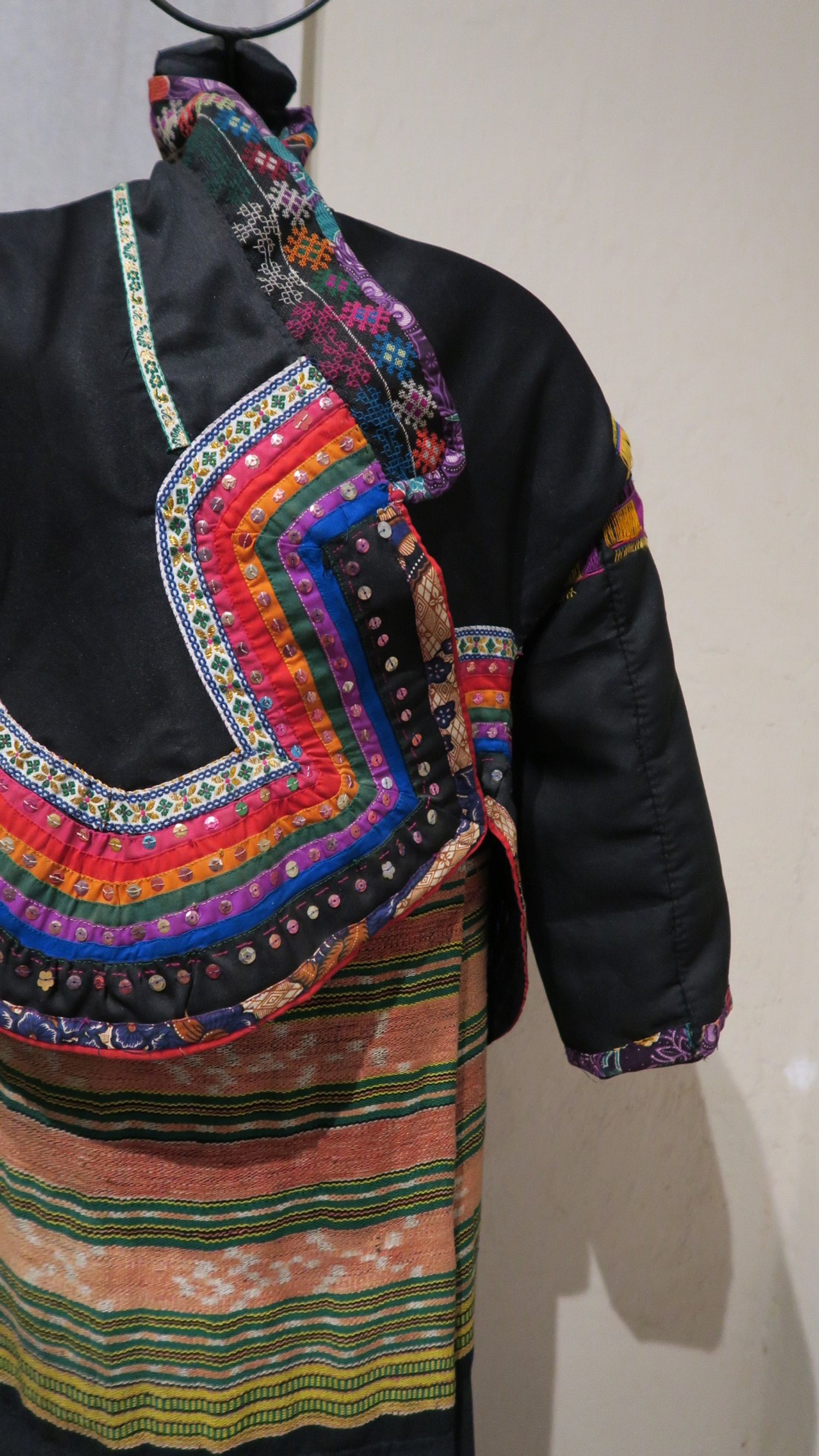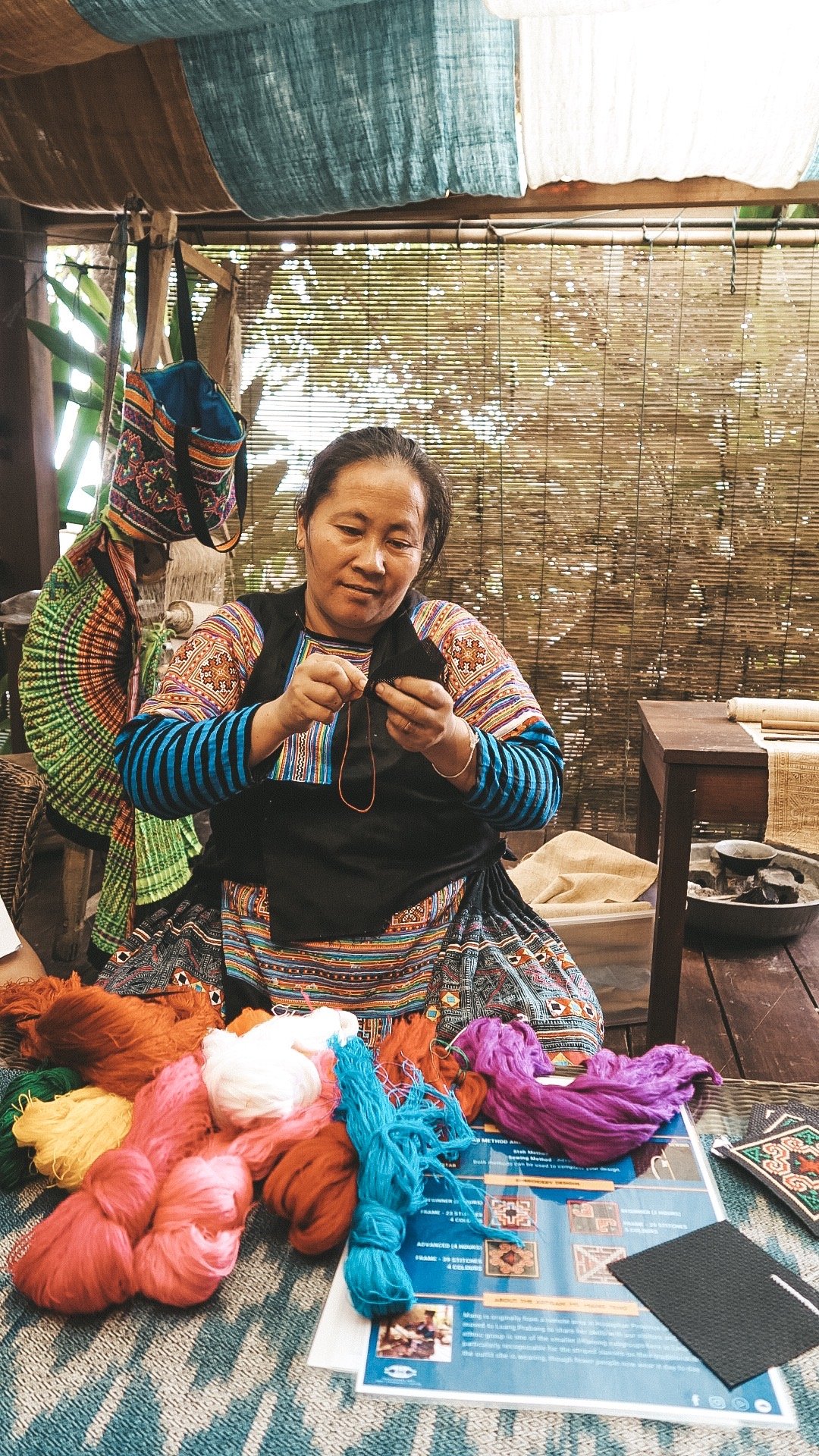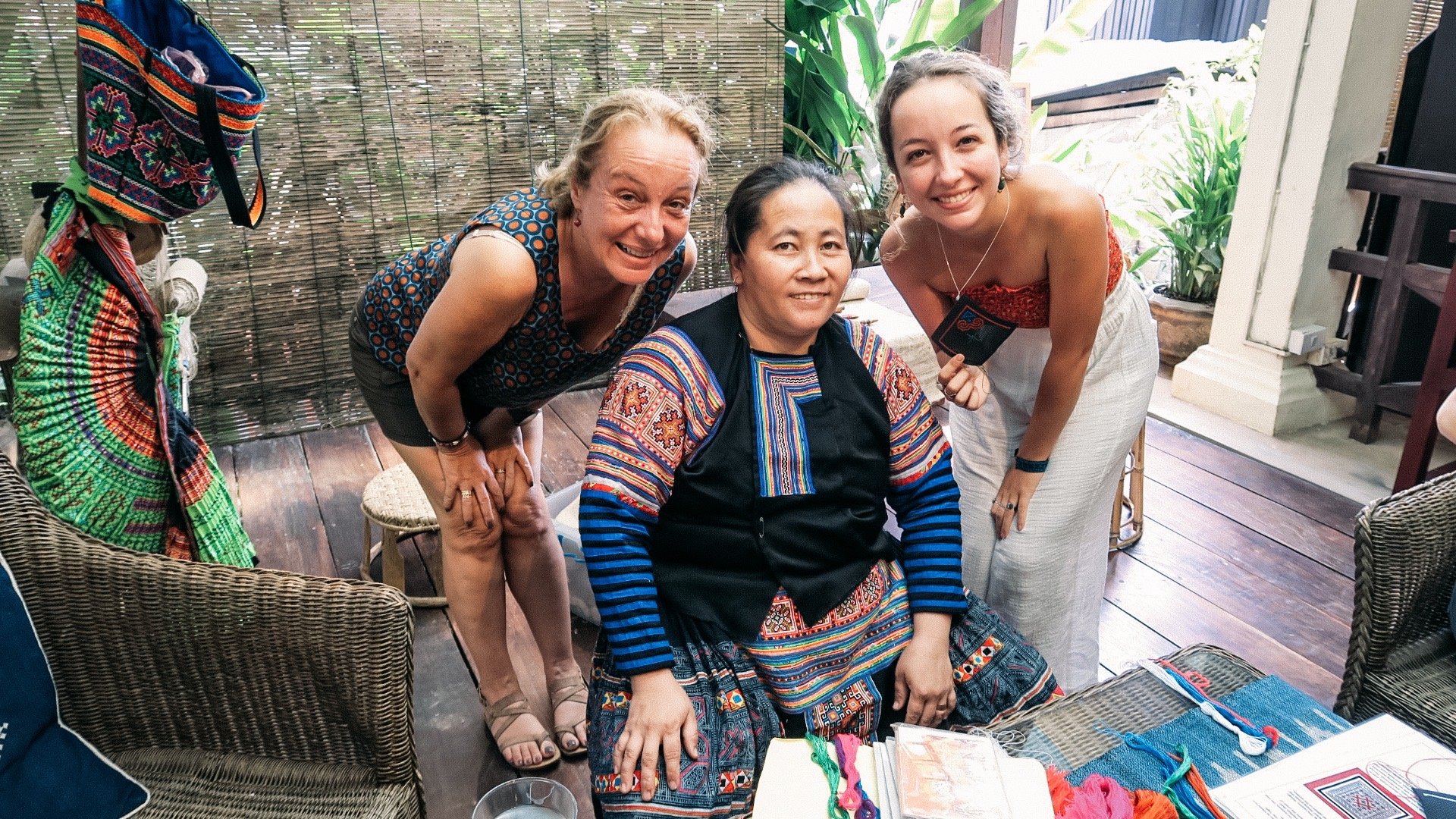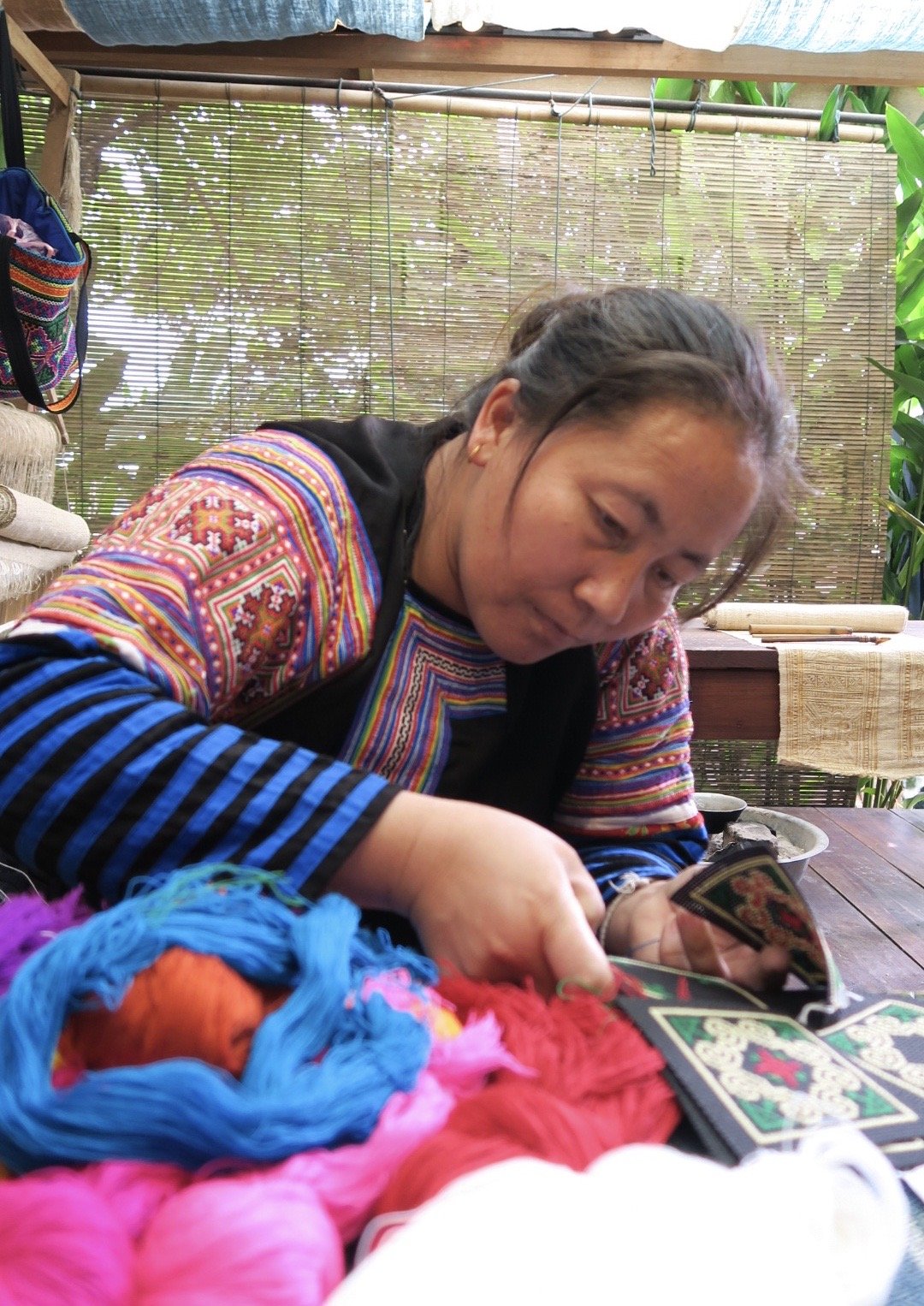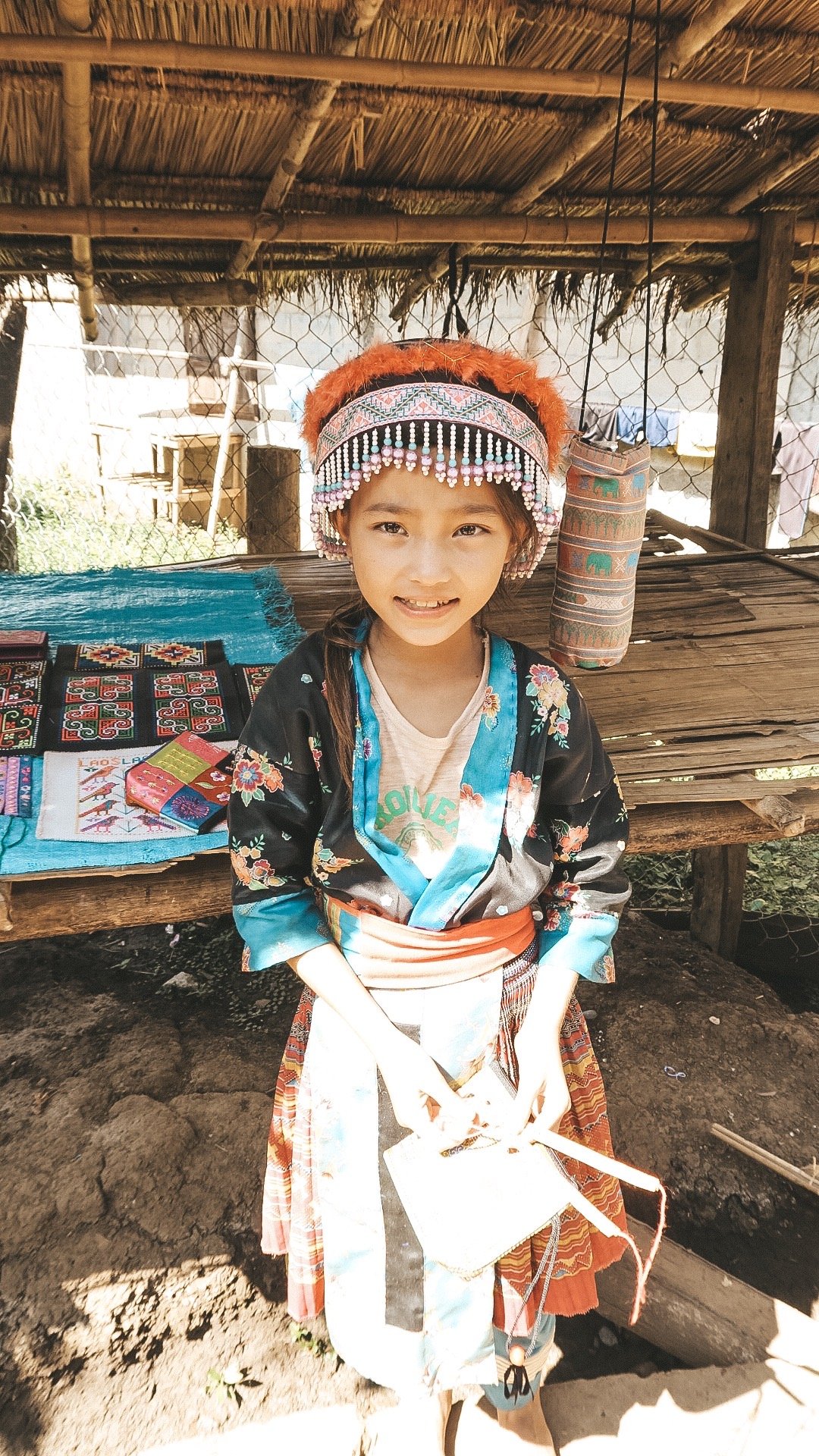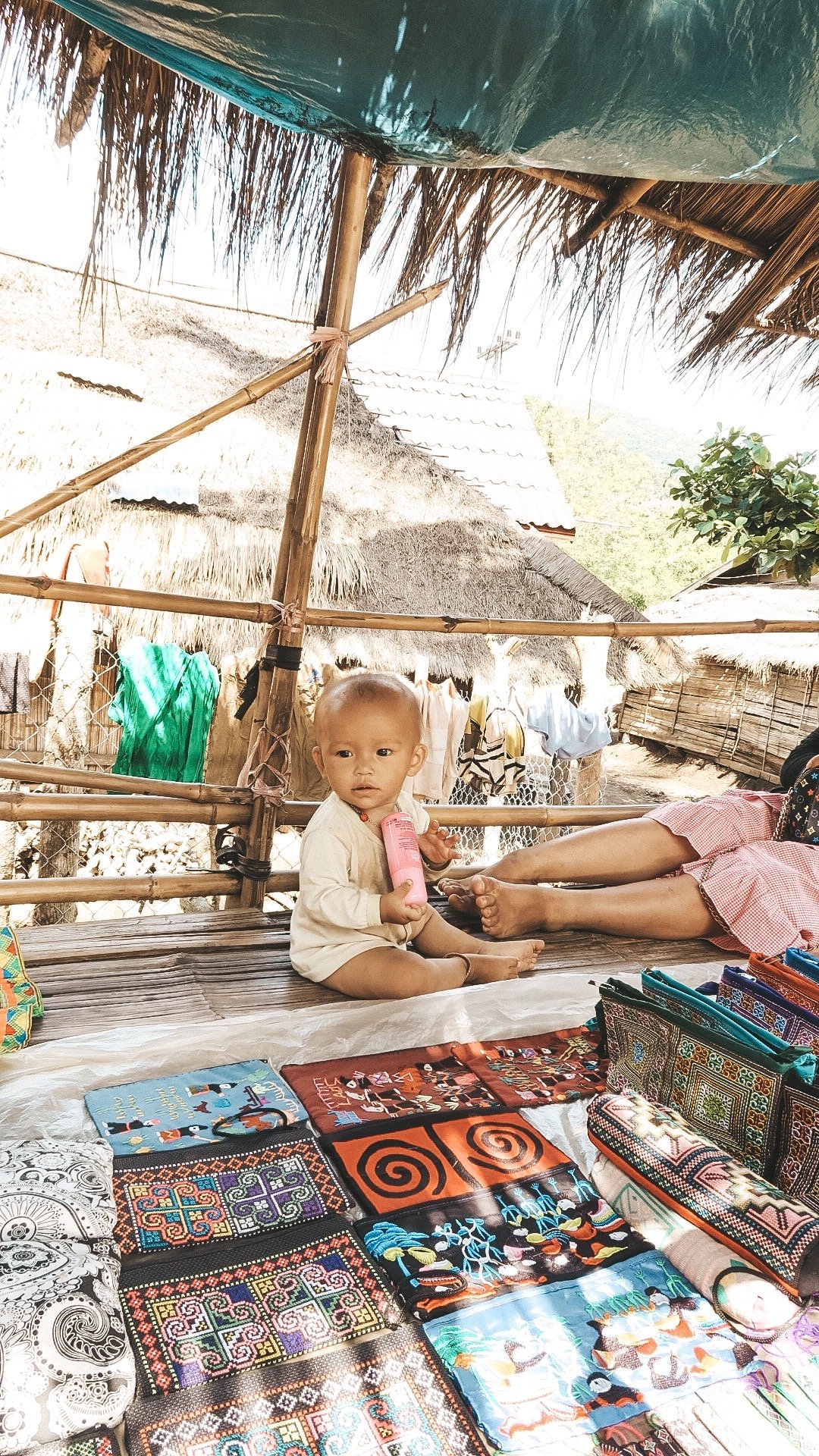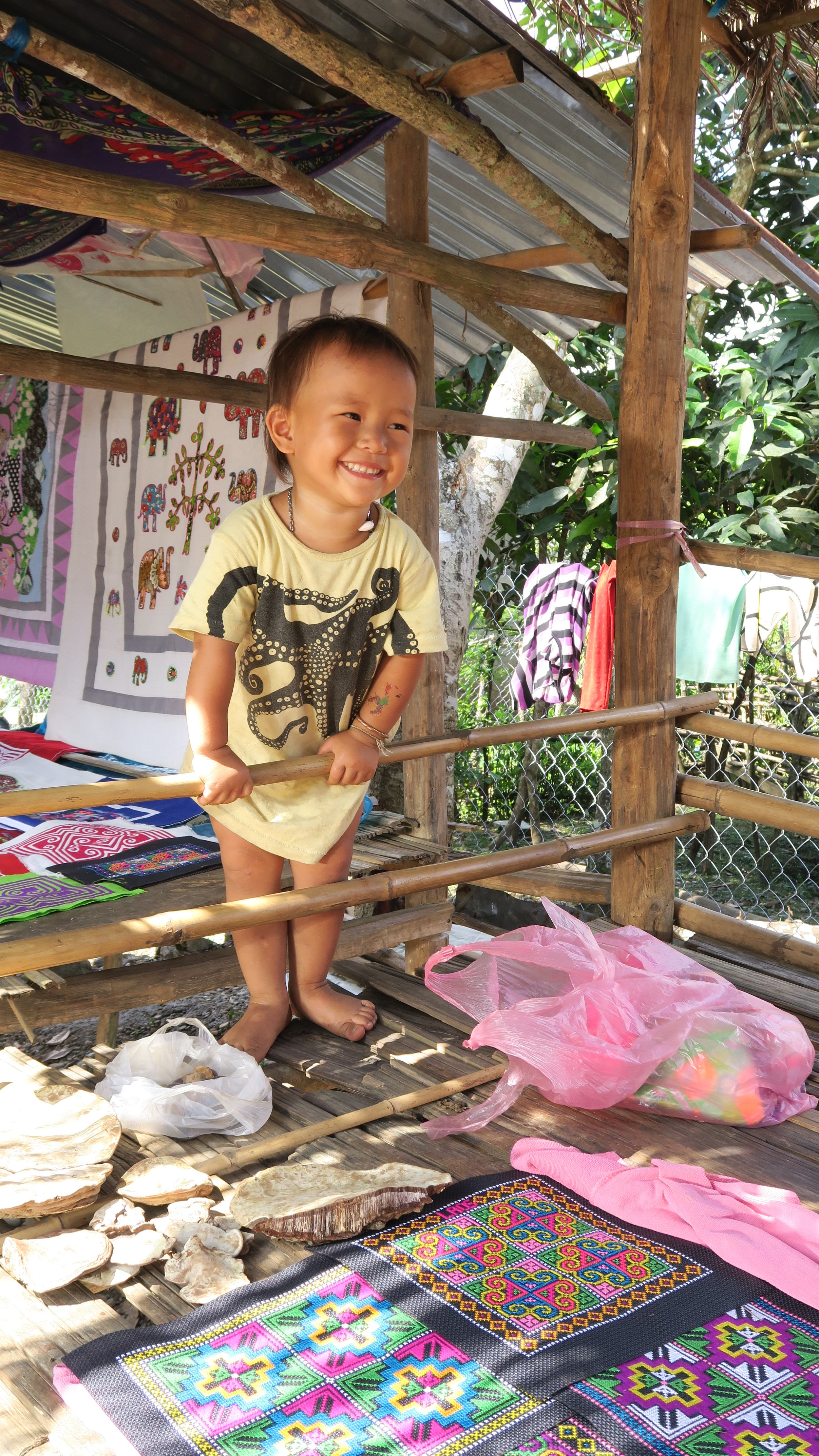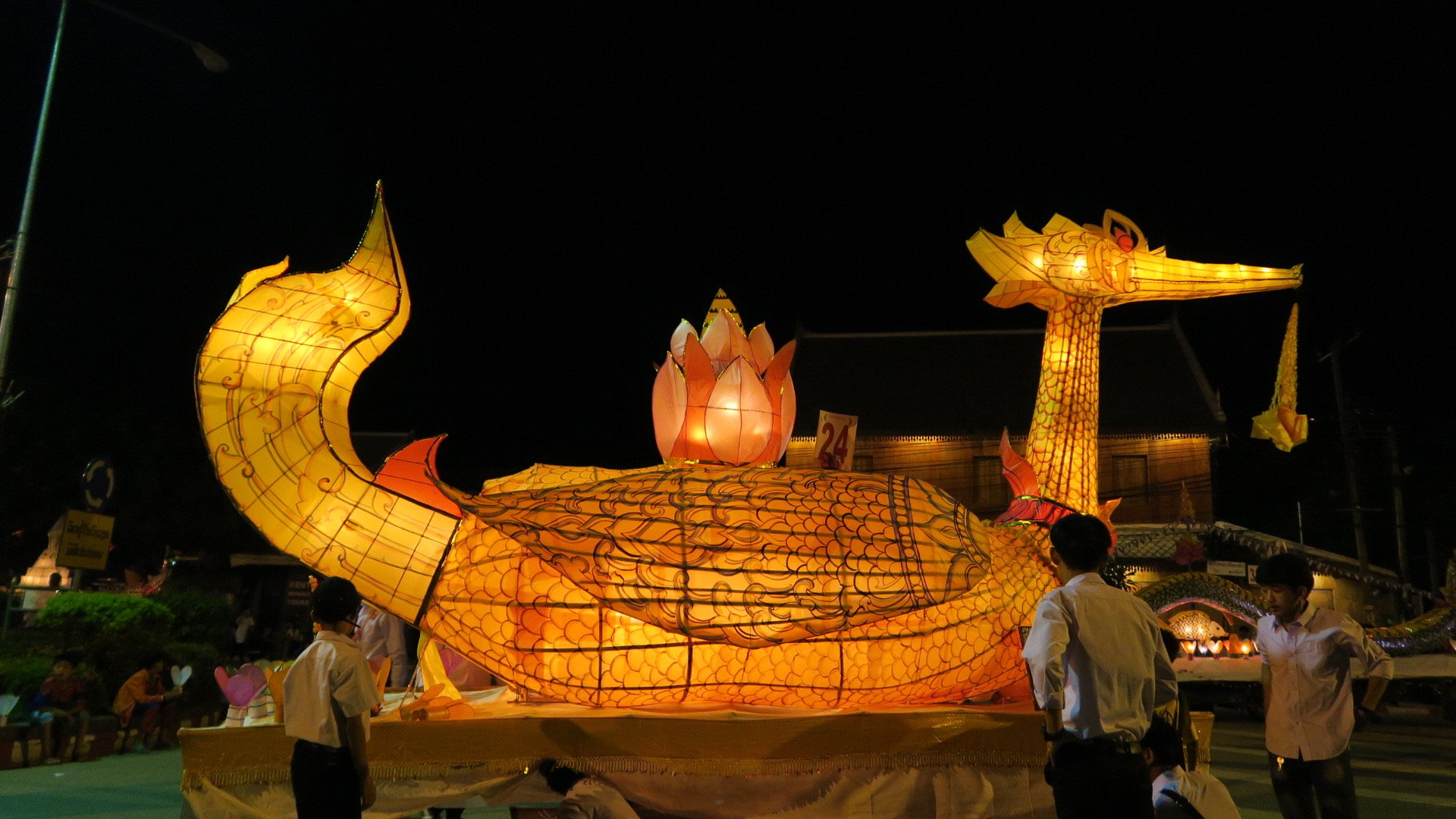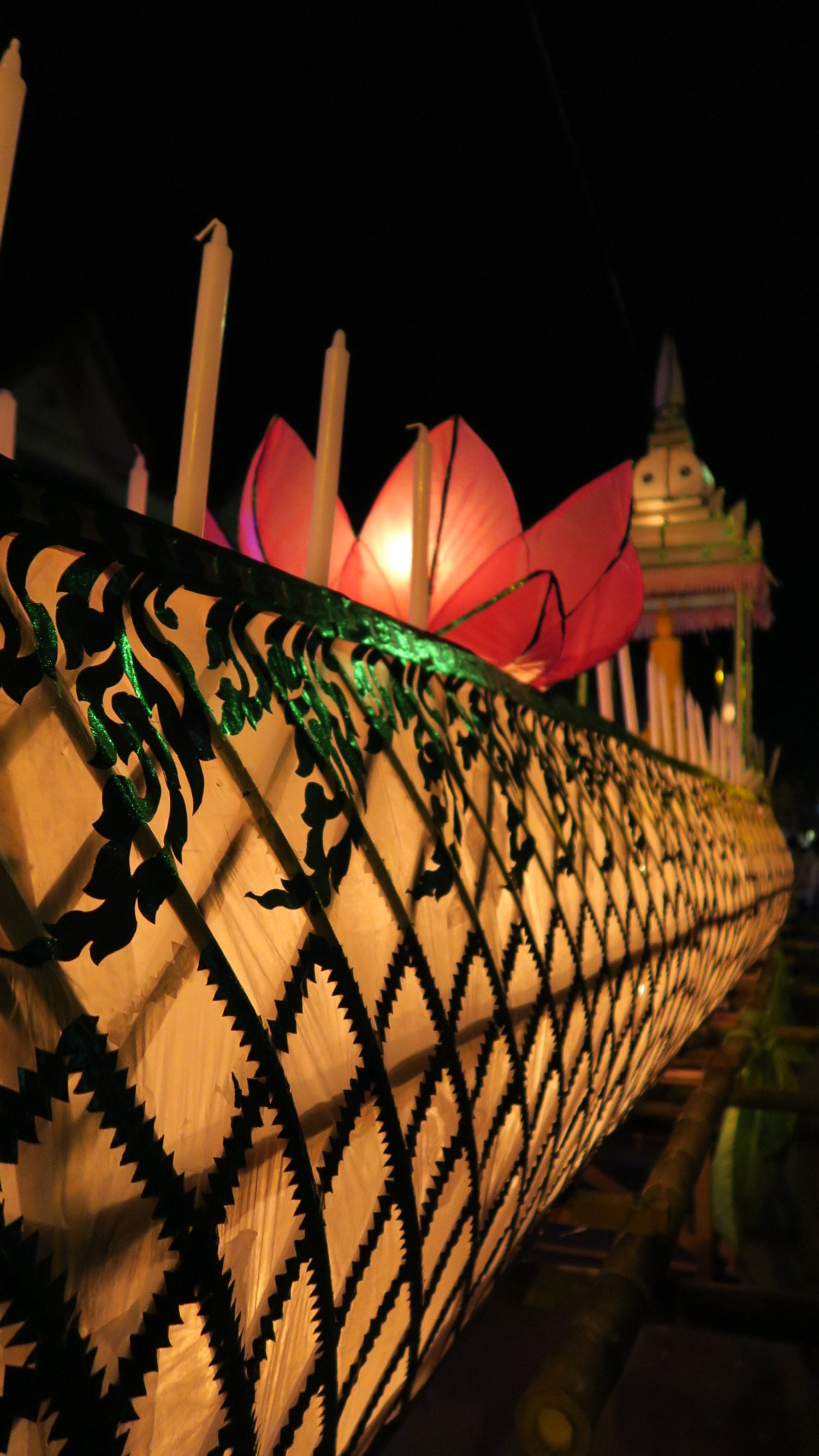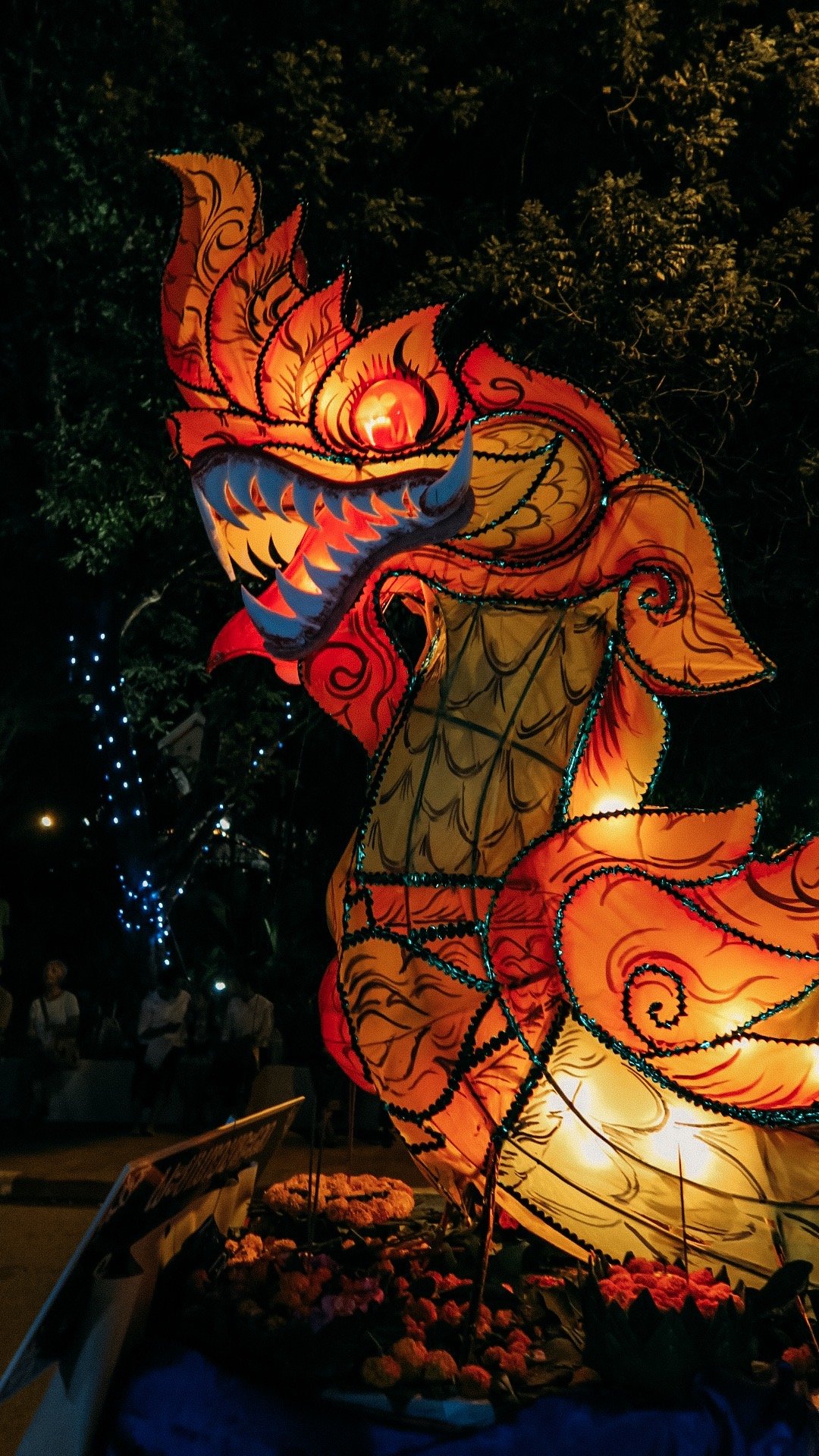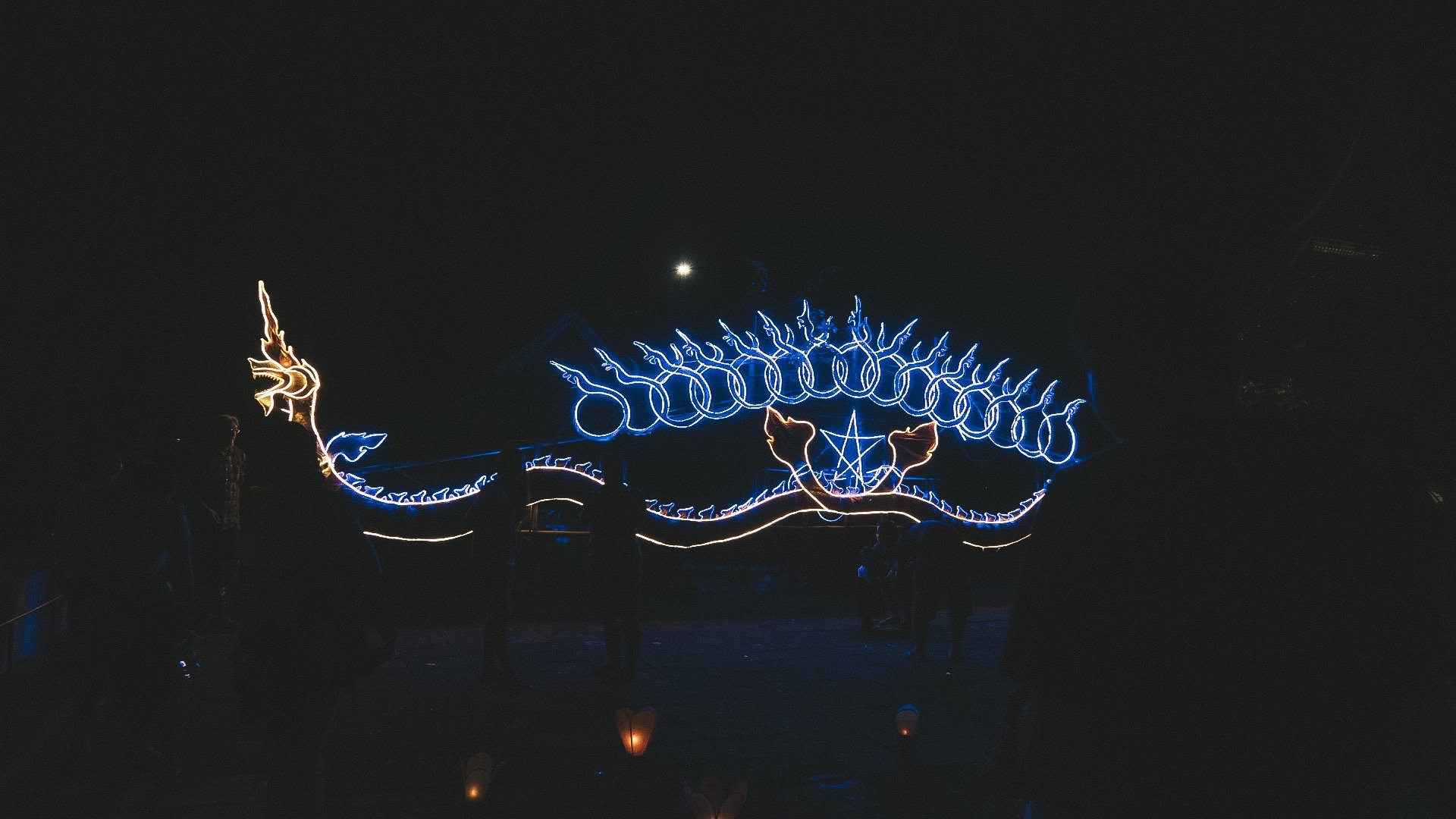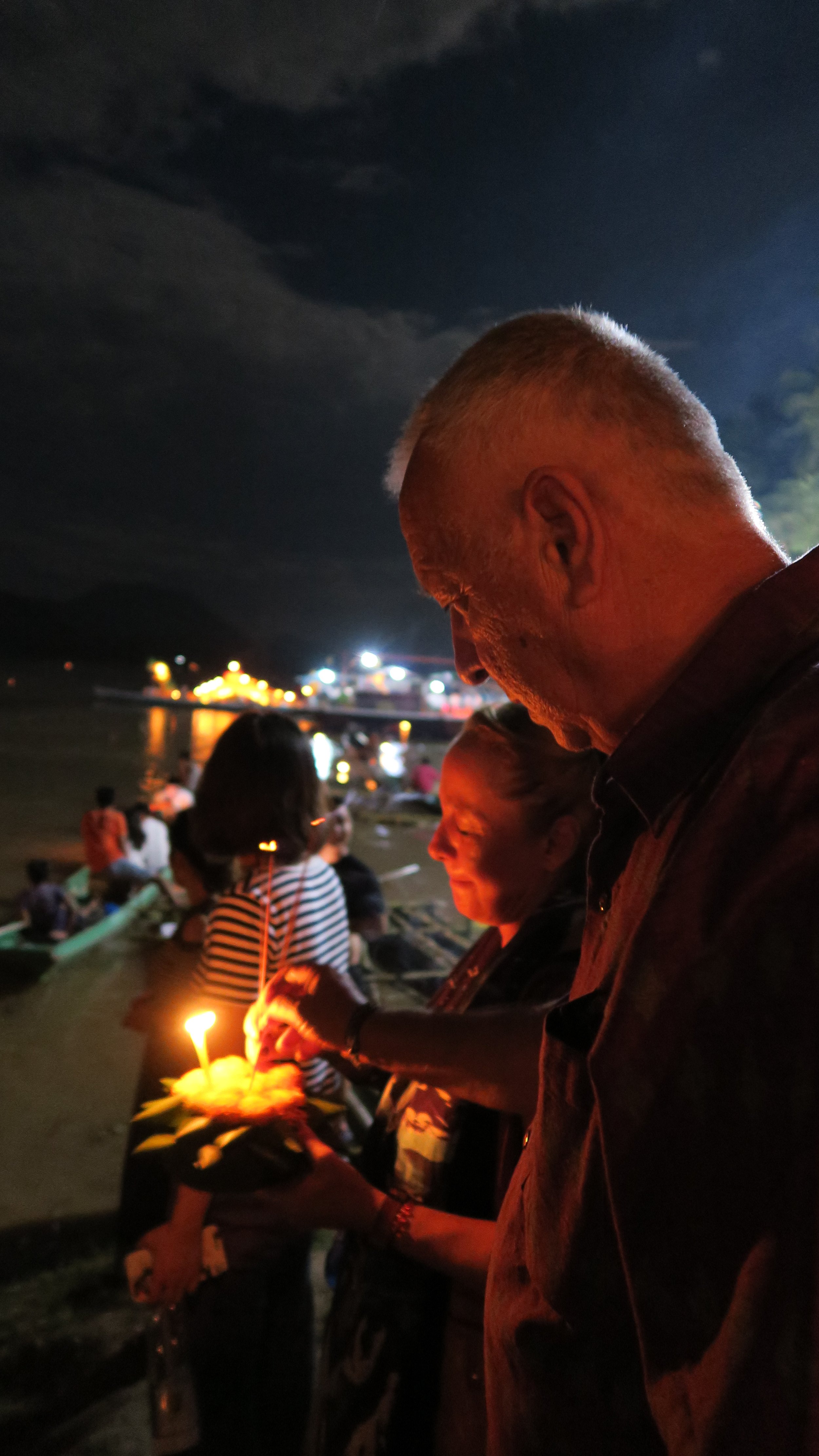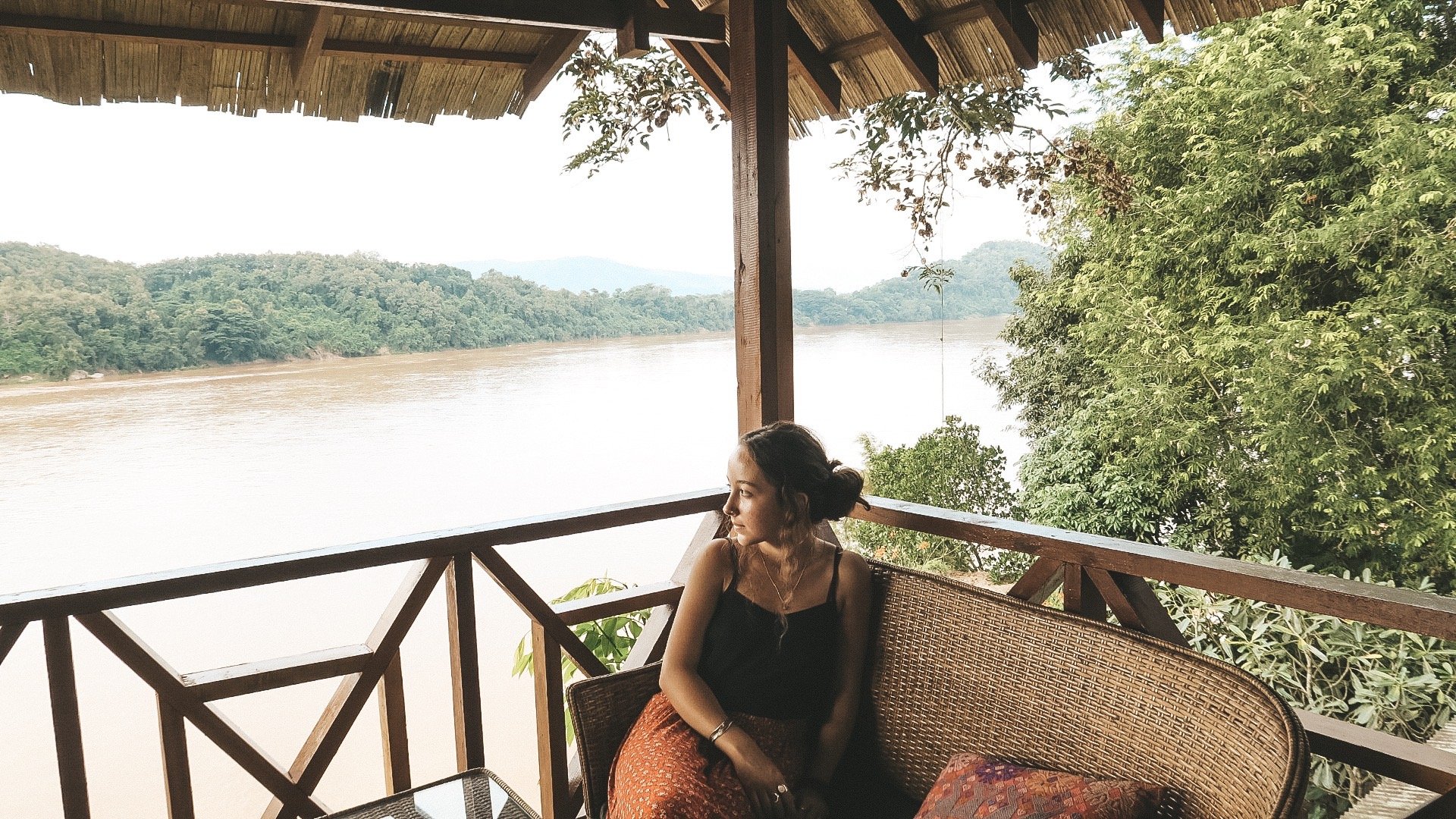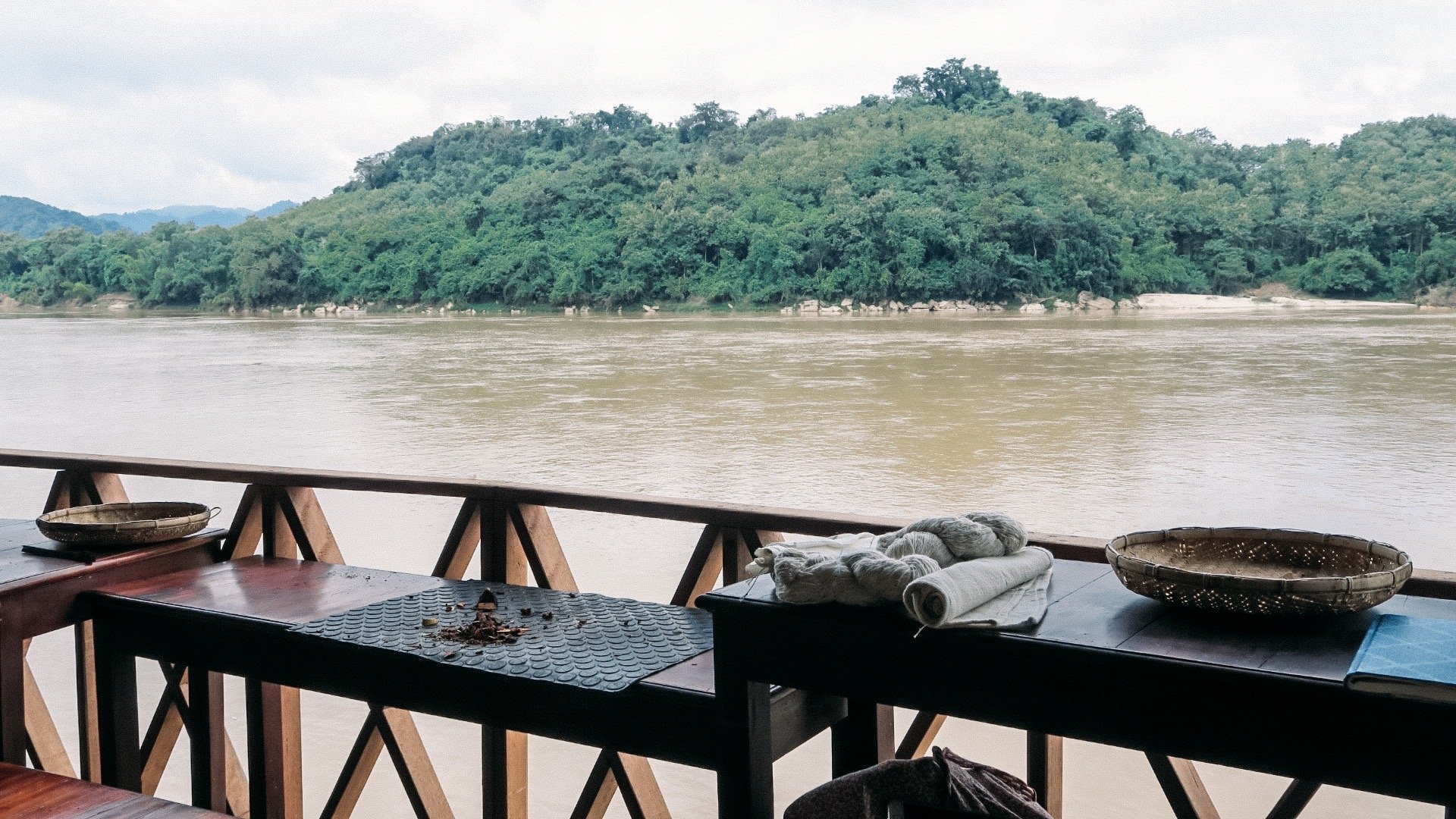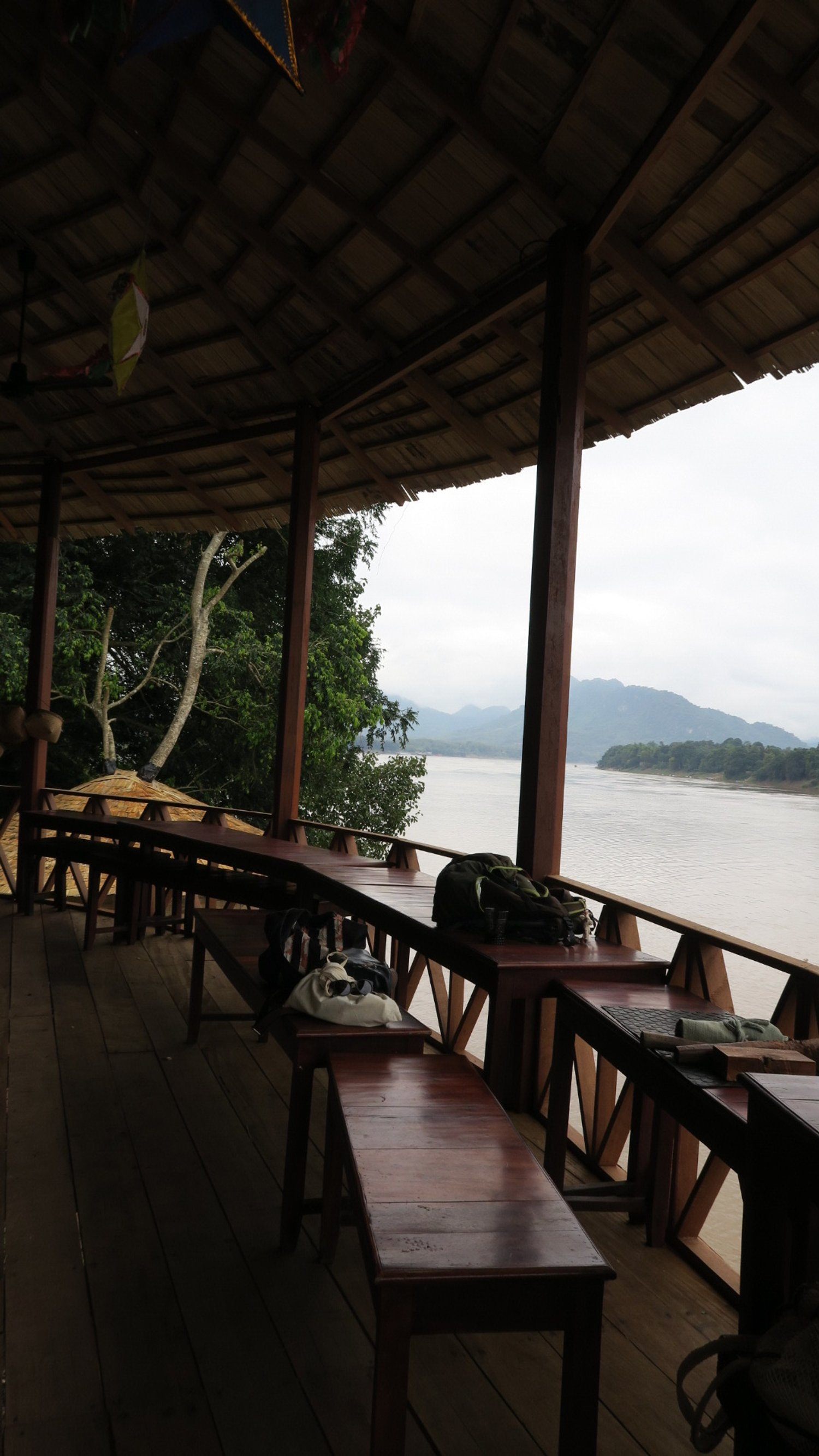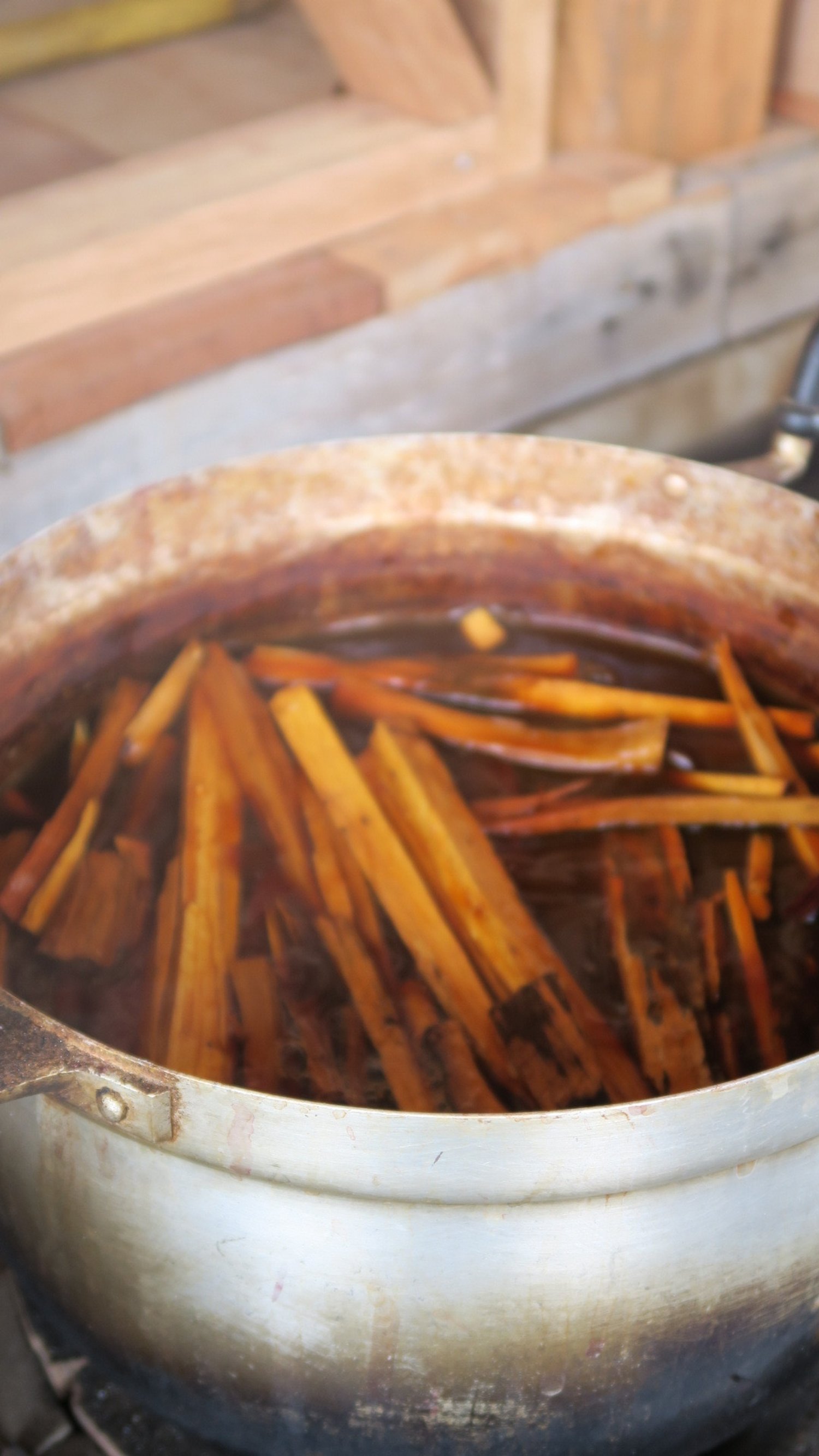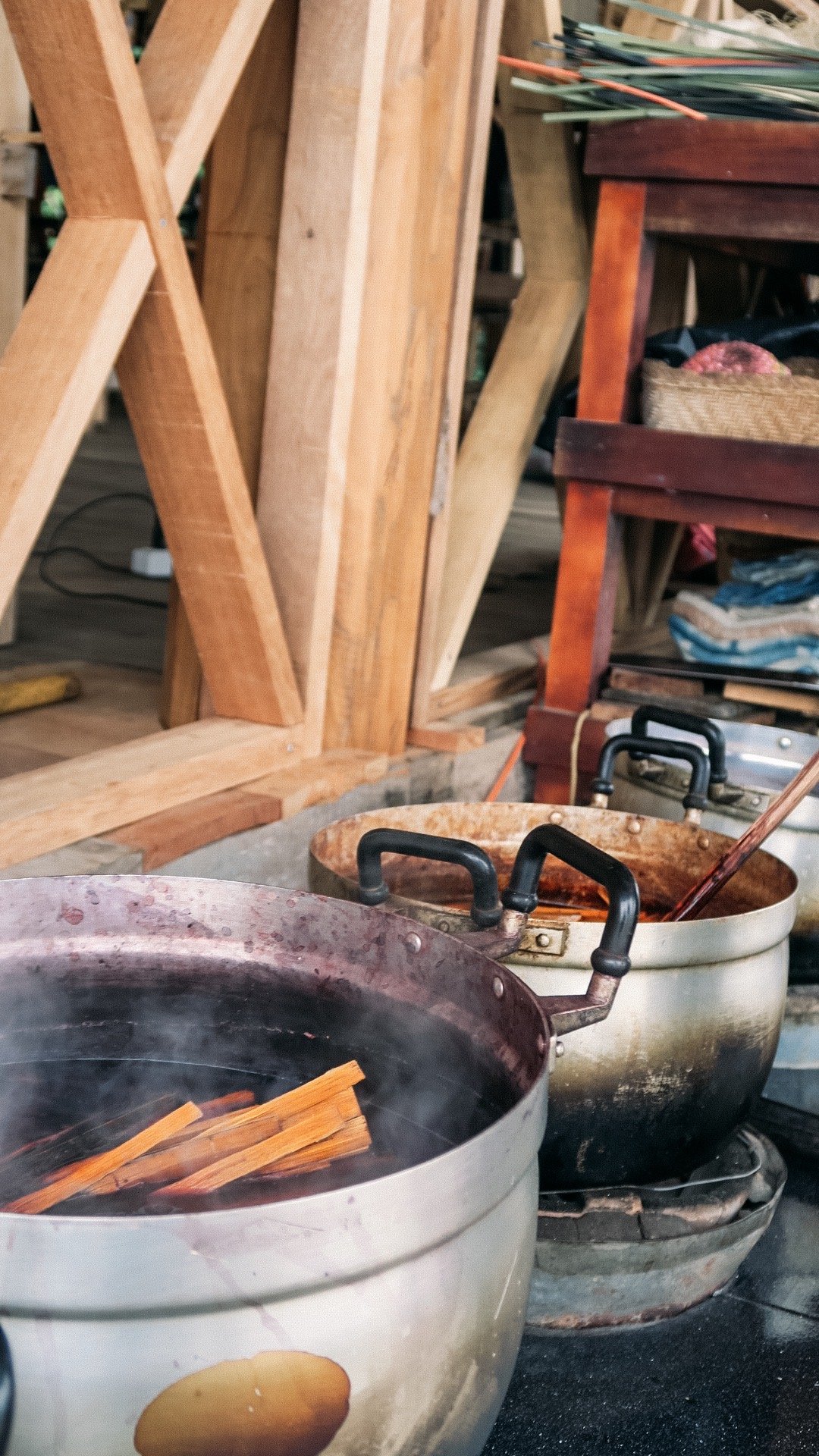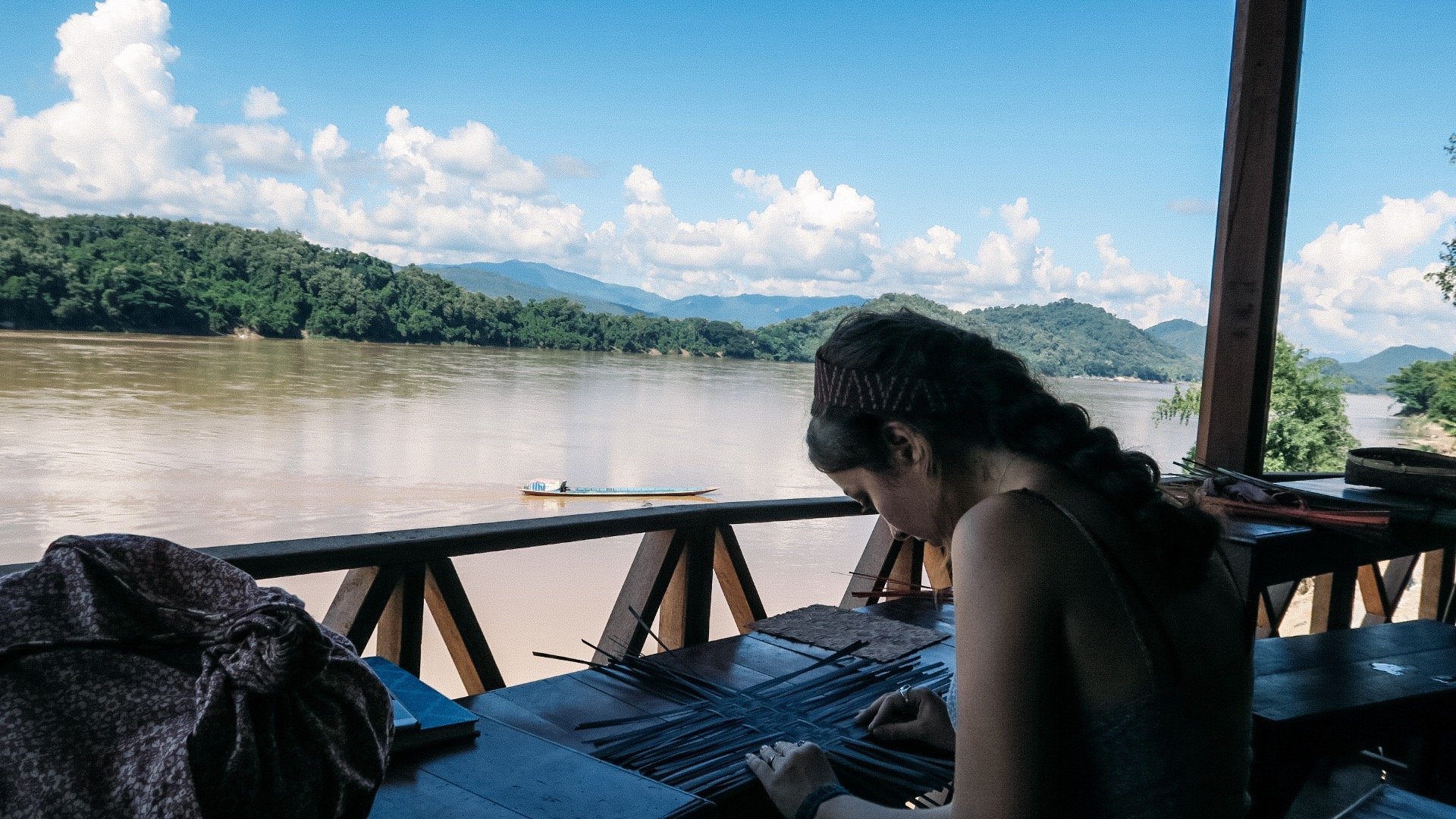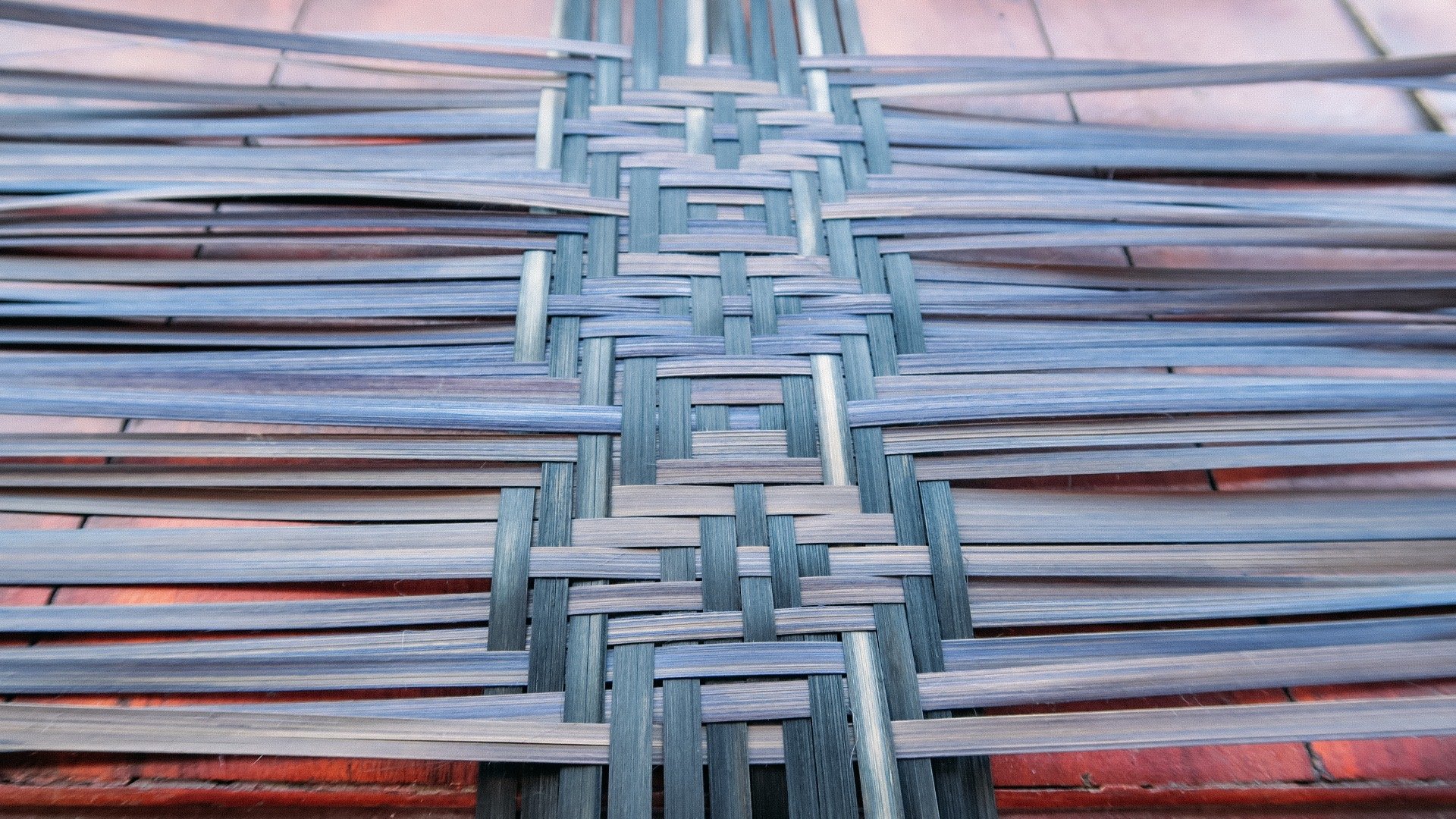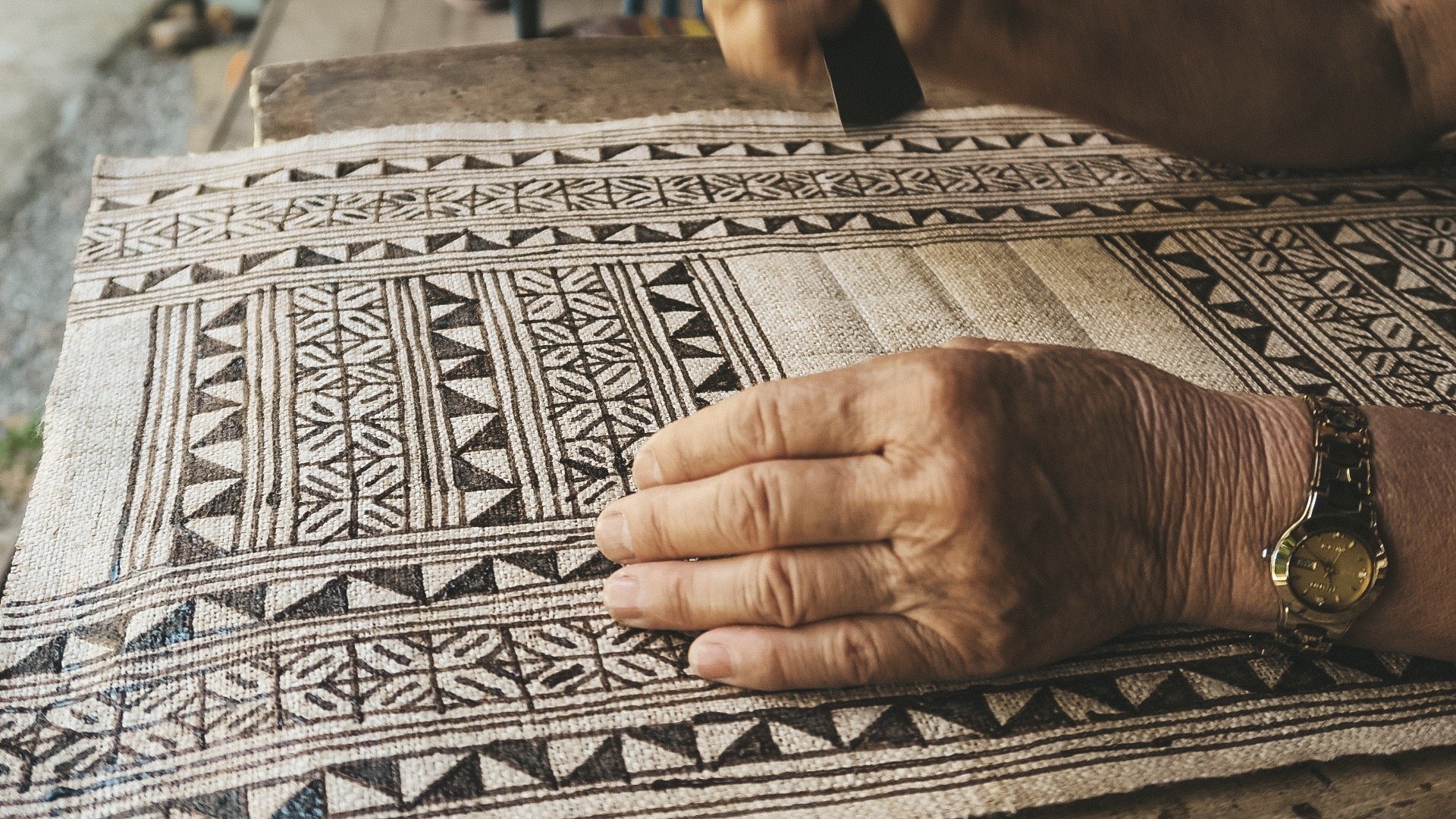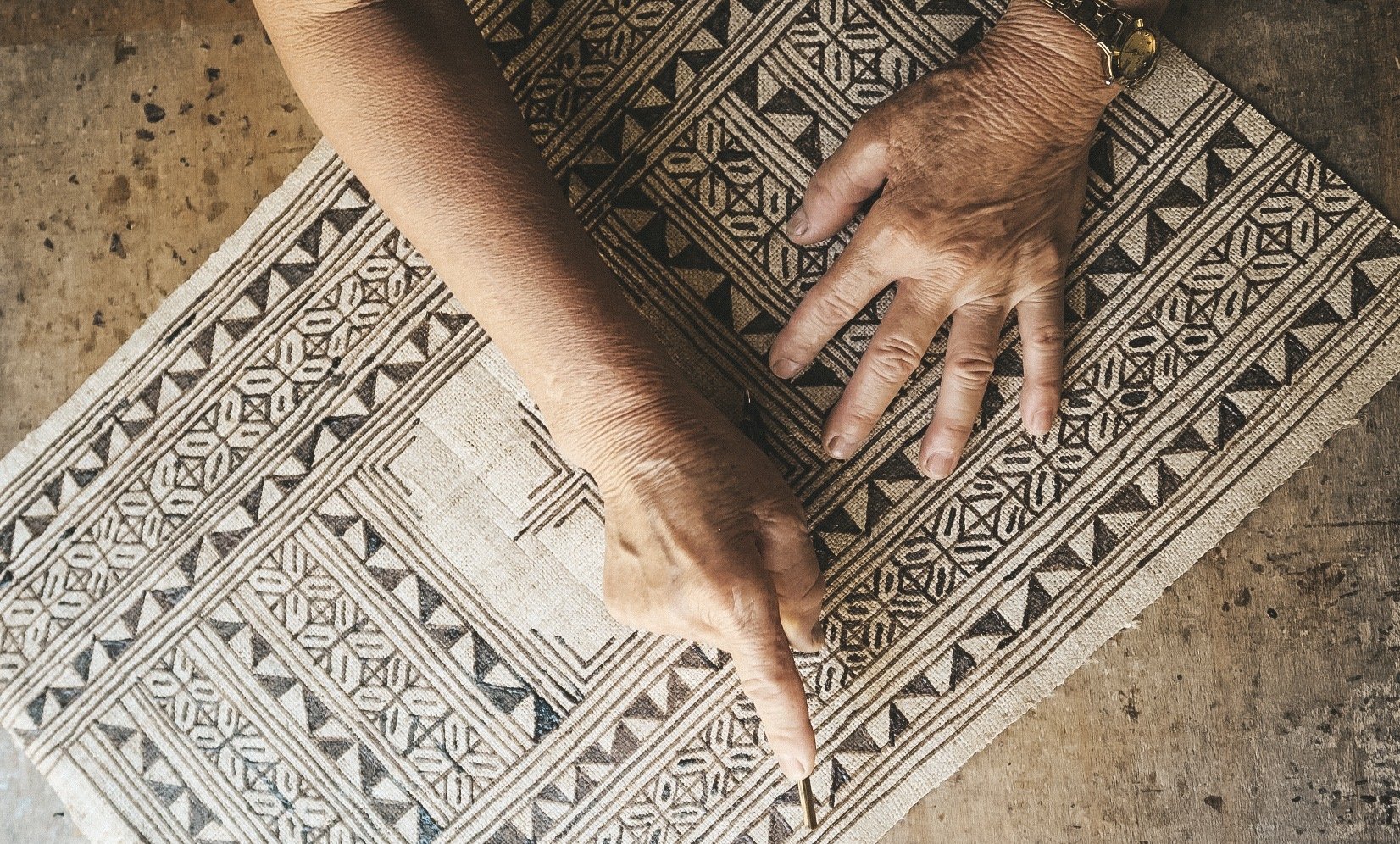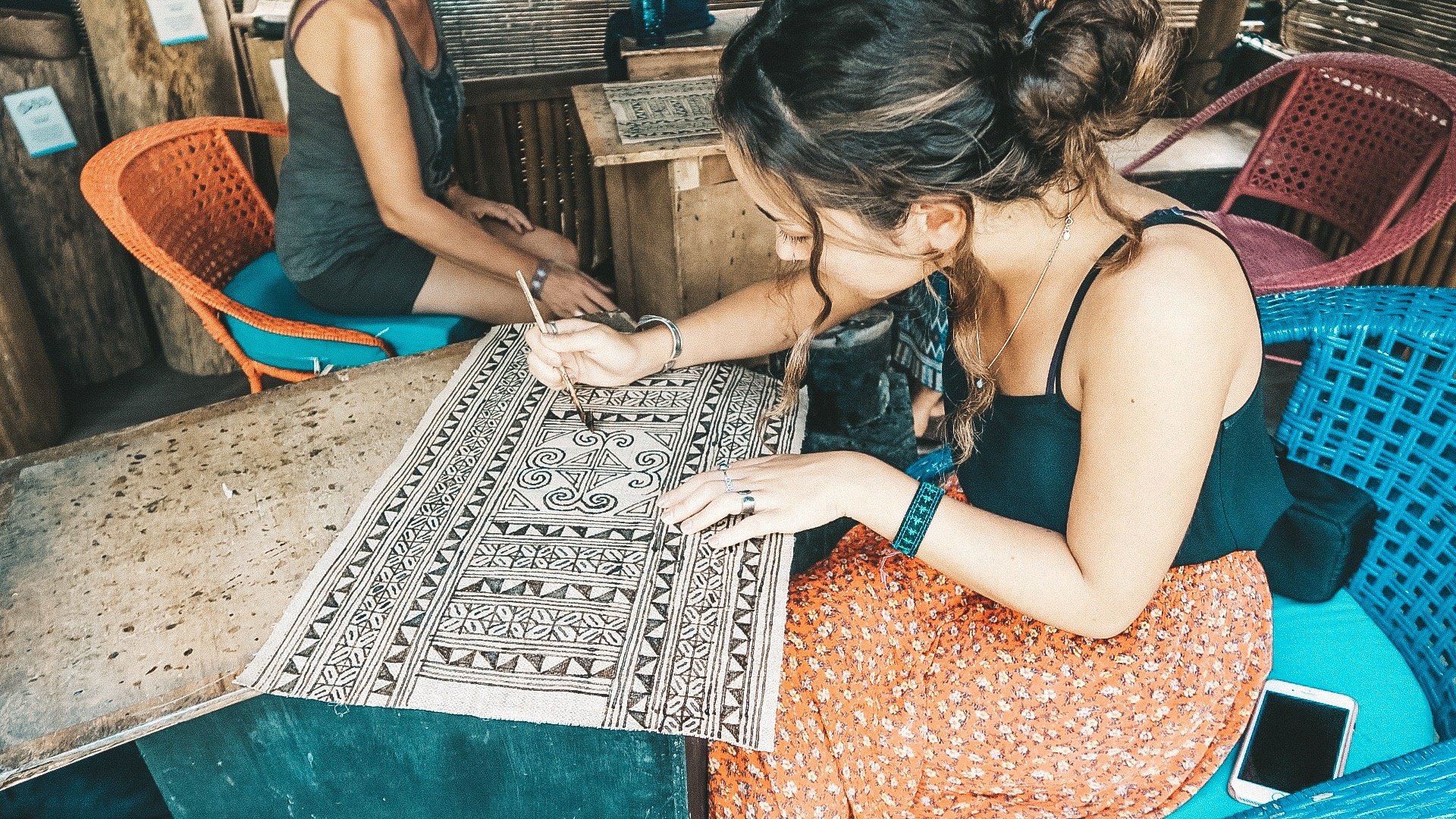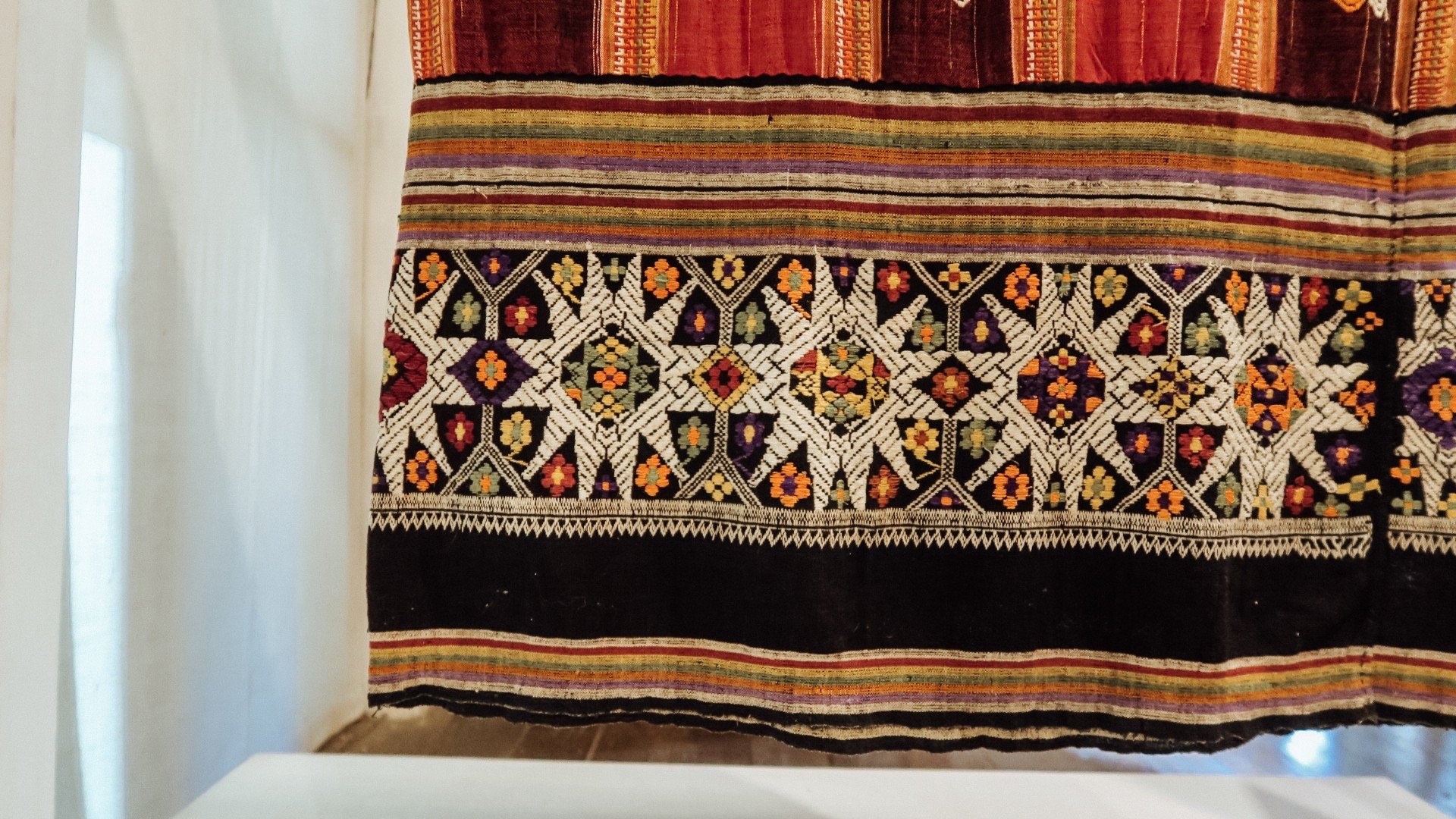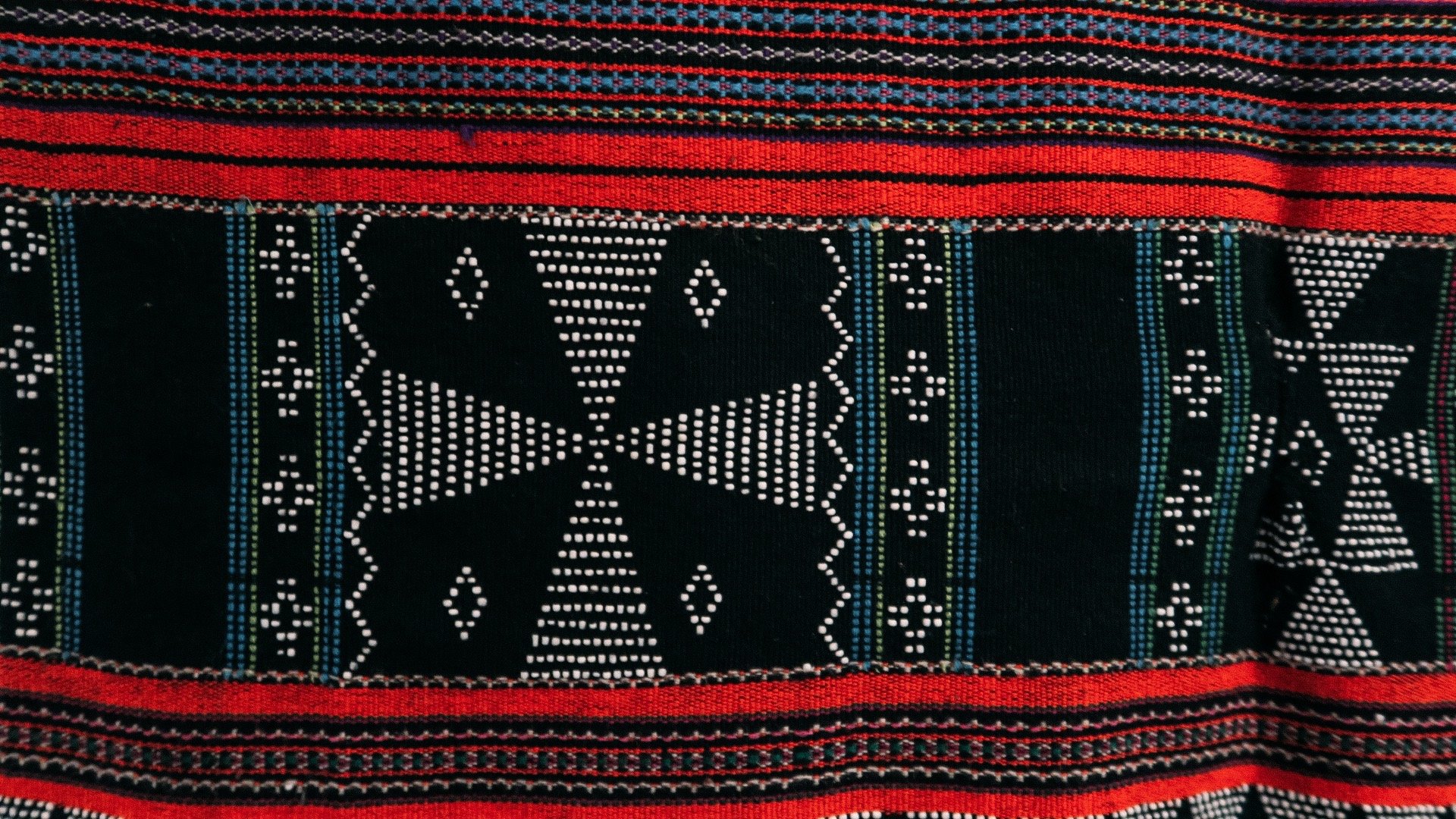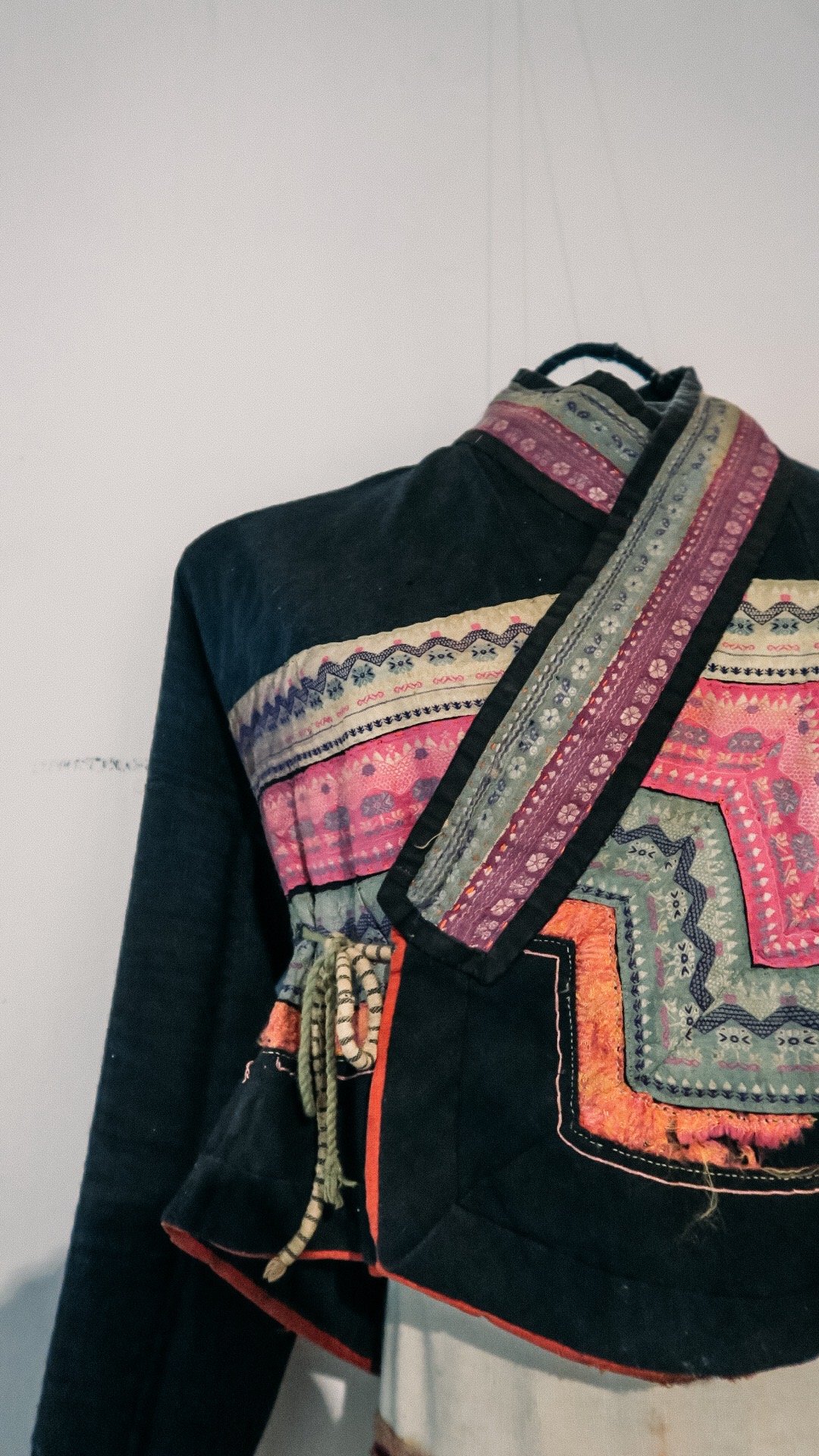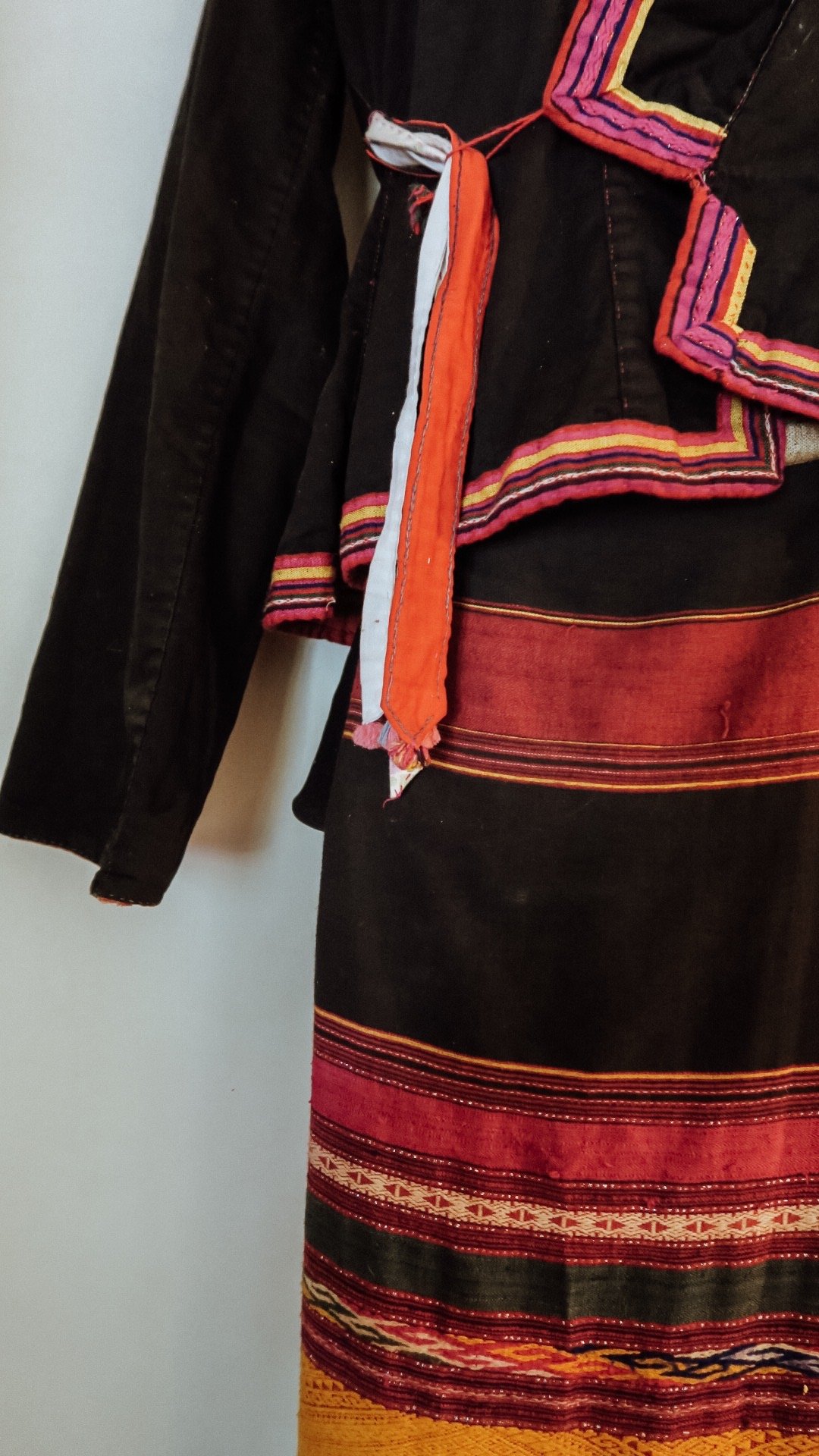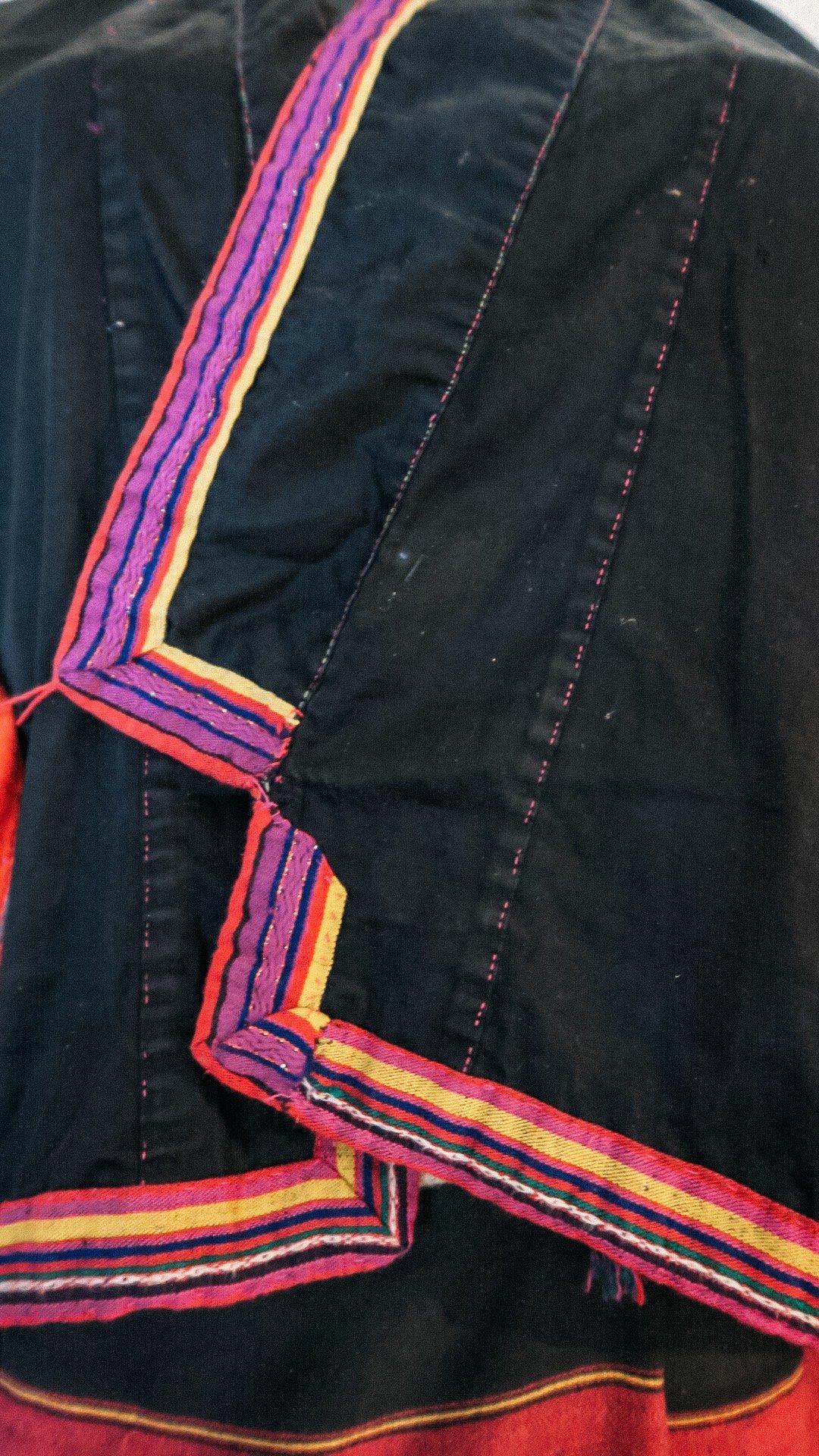Laos Weeks Eight & Nine: Luang Prabang
Luang Prabang was probably the place I was the most excited about, when I started planning my trip in S.E.A. A UNESCO World Heritage town that is quiet and peaceful, full of temples, surrounded by the jungle, waterfalls and caves. Next to the river, with mount Phousi and it’s amazing view, french and lao fusion restaurants, french bakeries, museums, shops and of course textile heaven: Ock Pop Tok.
My parents found me in Luang Prabang and we spent around two weeks together, in Luang Prabang and in Hanoi, Vietnam (next blog post).
The first day, I arrived earlier than them and decided to go for a walk. This city is definitely the cleanest city I have seen in Asia. There are almost no cars, a few tuk tuks, most people speak english, there are rubbish cans in almost every street and in general it’s very quiet.
First, I went to some textile shops. Here is a list of my favourites:
All of them had a mix of traditional and modern textiles, woven, embroidered, embellished and/or dyed.
Here are some photos from my walk:
I also went to the Traditional Arts and Ethnology Centre. Before arriving to Luang Prabang I had booked a Hmong Embroidery workshop at the TAEC, for the next day with my mum. However, since I wanted to spend a lot of time in the museum taking notes and looking at the textiles in detail, I decided to go even though I was going to go the following day.
The Traditional Arts and Ethnology Centre is a local social enterprise founded in 2006 to promote the appreciation and transmission of Laos’ ethnic cultural heritage and livelihoods based on traditional skills. It is a museum as well as a fair trade handicraft shop which is directly linked with artisan communities across Laos.
There are four main ethnolinguistic groups found in Laos. The ancestors of many of these people share common origins in southeast China, having migrated south to escape conflicts with the Han Chinese and to seek farming and trade opportunities. The four groups are: Austroasiatic - comprising of the Ta Oy, Lamet, Katang and Khmhu groups, the Hmong Yao (also known as Miao- Yao) which consist of the Yao Mien, (H)mong and Yao mun people, the Tai - Kadai which consists of the Tai Dam groups and finally, the Sino-Tibetan which consist of the Lahu, Phounoy, Lolo and Akha.
The tunics that you can see further down are all dyed with indigo, dipped in many times to achieve this dark almost black colour. The Akha people decorate them with long silver chains, hoops and coins.
My favourite exhibit was that of the skirts. The accordion pleat is achieved by neatly folding the fabric, stitching it tightly in place with a long thread and storing it that way to set. Sometimes, two narrow pieces of wood are bound to the ends to compress the pleats further. When the time comes the thread is removed and the skirt is opened up for wearing. Traditionally, every Hmong household would have produced it’s own textiles from start to finish. Girls would learn how to embroider, appliqué, indigo dye and batik from a very young age. However, now women usually purchase batik cloth from Hmong traders and just embellish it using chemical dyed thread and fabrics.
The bedding material which you can see in photos 9 and 10 are made by the Tai Dam Women. Traditionally, they made all of their own bedding materials, such as mattresses, pillows, blankets, curtains and mosquito nets. They wove, naturally dyed, and decorated (with appliqué or embroidery) all of these items. The mosquito nets were made from thick, indigo hand spun cotton fabric with their top decorated with appliquéd geometric shapes.
The next day, after meeting up with my parents, my mum and I went back to the TAEC for our Hmong embroidery workshop. There we were greeted by the manager, Sengphet. He introduced us to our teacher Mang Teng, who was from the flower Hmong tribe. She couldn’t speak any english however, Sengphet stayed with us translating any questions and helping us.
Hmong people use many symbols. Colours as well as designs are very important and mean different things. The Hmong are known for their batik (wax resist technique) Pa Ndau (reverse applique which is usually done with red fabric) and cross stitch embroidery.
We were shown four different traditional patterns and we had to choose one and follow the steps. My mum’s chosen pattern symbolised home unity, while mine symbolised wisdom and longevity. Unfortunately, we used chemically dyed thread. The class took three hours, so we ended up taking some threads and our piece home to finish it off.
Some of my favourite restaurants, cafes and bars in Luang Prabang:
Big Tree Cafe: Korean - Lao fusion, very cheap, huge portions and great food, and you can sit outside in a small garden.
Blue Lagoon Restaurant: German - lao fusion.
Bouang Asian Eatery: Music, food and drinks are lovely here.
Icon Klub: Small and cosy bar, with great music and cocktails.
L’elephant: French cuisine.
Manda de Laos: Amazing atmosphere, eating next to lotus lakes, great music and fantastic Lao food with a twist.
Saffron Coffee’s Espresso: Best coffee.
Secret Pizza: Probably one of the best pizzas I’ve ever had. The owner is Italian, the restaurant is in the middle of nowhere, there’s a wood oven and the restaurant is open only 2-3 times a week and is always full. Must visit.
Tamarind: Great Lao food, I recommend asking for the set menu. They also offer cooking classes.
Tangor Restaurant Bar and Lounge: Nice food and drinks, great atmosphere.
The following day, we decided to go to the Kuang Si waterfall. A three levelled waterfall about 30km south of Luang Prabang. We arranged a driver to take us, making a few stops along the way, to a Hmong village and the Butterfly Park.
At the village, a lady showed me how to spin cotton, and I bought some hand-spun un-dyed and some naturally dyed cotton skeins. The ladies didn’t speak english, however the driver helped translate how and with what plants the colours were made.
We arrived at the waterfalls, and did a bit of trekking before reaching the first natural pool. There we made the mistake of crossing the small bridge and going up through the right side of the falls. There isn’t a path there, and it’s very difficult to reach the top. After about 45 minutes we gave up and went back down again before going up from the left of the waterfalls (ie. the right way). The water was cold, however it was an amazing experience.
The Kuang Si Butterfly Park is only 300 metres from the waterfall. It opened in 2014 as a breeding sanctuary for Laos' butterflies. You can walk around and see many of the butterflies in their natural environment.
We were very lucky because while we were at Luang Prabang there was a light festival. It’s called Boun Heua Fai. The day is celebrated by illuminating boat processions. The boats are all handmade with bamboo and banana trunks and colourfully decorated with candles, flowers, garlands and drawings. Each family and business has to make one. There is a parade that happens on that day. There is a competition, on who made the most beautiful boat, and the family or business wins some money. The parade ends opposite the Wat Xiengthong temple (probably one of the most beautiful temples in Asia) people put the boats one by one in the river and leave them to float away, paying respect to the spirit of water.
It’s a beautiful celebration, full of smiles, colours, light, dancing, flowers and of course food. We purchased a small offering (made out of bamboo leaves, flowers and a candle) and put it in the river as well. Here are some photos of the festival:
The next few days we spent them at the Ock Pop Tok Living Crafts Centre.
This organisation was founded in 2000 by two women, Joanna Smith and Veomanee Douangdala. Ock Pop Tok grew from a small shop selling only a few designs, to becoming one of the most important textile and artisanal institutions in South East Asia. Ock Pop Tok means "East meets West" in Lao and it was founded on the principles of fair trade and sustainable business practices.
The two women started working together in 1999 when Jo was on an EU funded assignment to photograph development projects in northern Laos. At that time Veo was starting out her career, making a name for herself among the Lao artisan community. She was designing unique sinhs (traditional skirts) and patterns that differentiated her from her peers, a mix of modern and traditional. (Ock Pop Tok, 2019)
The two women had a shared commitment to preserving and promoting these textiles, and that’s how the organisation was founded.
“Veo and Jo realized early on that in order for hand loomed textiles to survive and thrive as a craft, they had to create economic value for the textiles. Weaving, which is still done primarily by village women, is often considered domestic work that is not representative of progress or economic advancement. By deciding to operate on fair trade principles, specifically by providing competitive wages, opportunities for continued learning and professional development, Ock Pop Tok gave village weavers the ability to earn a sustainable livelihood for their families and communities. They opened a venue where visitors could see and practice the craft. In this way the two were able to educate visitors about the cultural and the artistic value of the textiles.” (Ock Pop Tok, 2019)
Here are a few photos of the amazing venue:
Weaving on treehouses, preparing the dyestuff while looking at the river, batiking next to plants used to dye with - the experience was unforgettable.
The first day I did a half day natural dyeing workshop and a half day bamboo weaving workshop. Before starting with the workshops, we were taken on a tour around the venue. During this tour I learnt a lot about silk.
Silk
In Laos there are two types of silkworms: the Eri and the Bombyx Mori. The second one originated in China and eats mulberry leaves. This silkworm makes yellow and white cocoons. The Eri originated in India and eats a variety of leaves but not mulberry. The yarn from the Eri cocoon is thick and textured creating very soft textiles that sometimes feel like wool. The Eri silkworm doesn’t produce a continuous filament and the moth can emerge from the cocoon unharmed — thus continuing its lifecycle. The Bombyx Mori silk is created by boiling cocoons to loosen the filaments, whereas for Eri silk the cocoons are brushed — therefore there is no harm done to the moths. In Laos, most producers of silk are Buddhists. When boiling the Bombyx Mori cocoons, women sing a type of redemption song that says sorry to the silkworm and promises to weave a butterfly motif in homage.
Natural Dyeing Workshop
I must say that after doing the intense natural dyeing course at Houey Hong in Vientiane, Laos the workshop at Ock Pop Tok disappointed me. There wasn’t much detail, we didn’t measure anything, no one explained anything about mordants to me… It was a fun workshop for tourists but not so much for people that are really interested and/or already know some things about natural dyeing. However, I talked to the team manager and explained and she did say that in the future a more specialised/professional workshop could be arranged but this would have to be discussed in advance.
That’s not to say that I didn’t enjoy the workshop or learn some new information. For example, some interesting cultural beliefs: Hmong people put a chilli on their indigo pot to make sure the spirit doesn’t escape, whereas the Tai Lue people tie white cotton thread around their indigo pots to keep the spirit inside.
Some of the natural dye stuff they use at Ock Pop Tok are:
Anato Tree - where they use the seeds to produce orange
Beetroot - where they use the fruit to produce reds and browns
Betel Tree- where they use the wood to produce brown
Ebony - where they use the bark and fruit to produce greys and black
Indian Trumpet - where they use the bark to produce light green and yellow using Iron as mordant
Indigo - where they use the fresh leaves and stem to produce blues
Jackfruit - where they use the wood to produce gold or yellow
Lemongrass - where they use the fresh leaves to produce yellow
Rosewood - where they use wood or bark to produce brown
Sappan Tree - where they use the heart wood or the roots to produce pink, purple and red, depending on mordant (Iron or Alum)
Sticklac - where they use the resin from the insect to produce red and purpleTeak - where they use the fresh leaves to produce creams and light pinks
Turmeric - where they use the root to produce bright yellows and oranges
Wild Almond - where they use fresh leaves to produce gold brown
I did this workshop with my mum, we dyed 2 cotton napkins and 1 silk scarf each. We used teak leaves, sappan tree bark, lemongrass and beetroot (different to the beetroot we are used to, see photo 2 below). We did some tying (shibori) to create some patterns. Like I said, we didn’t measure anything, we just cut the beetroots and barks in small pieces, ripped the leaves in small pieces and then boiled them. Here are some photos:
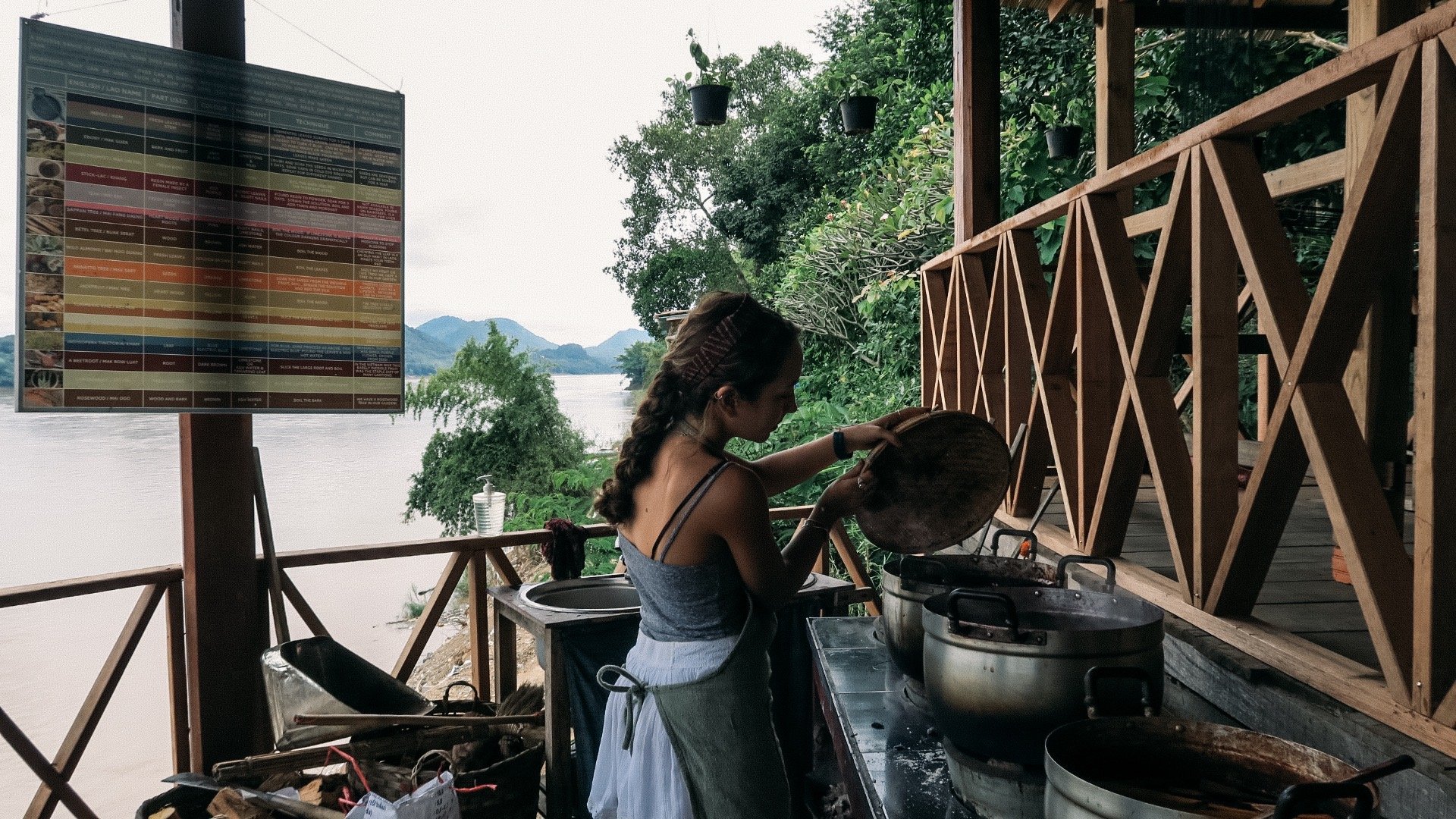
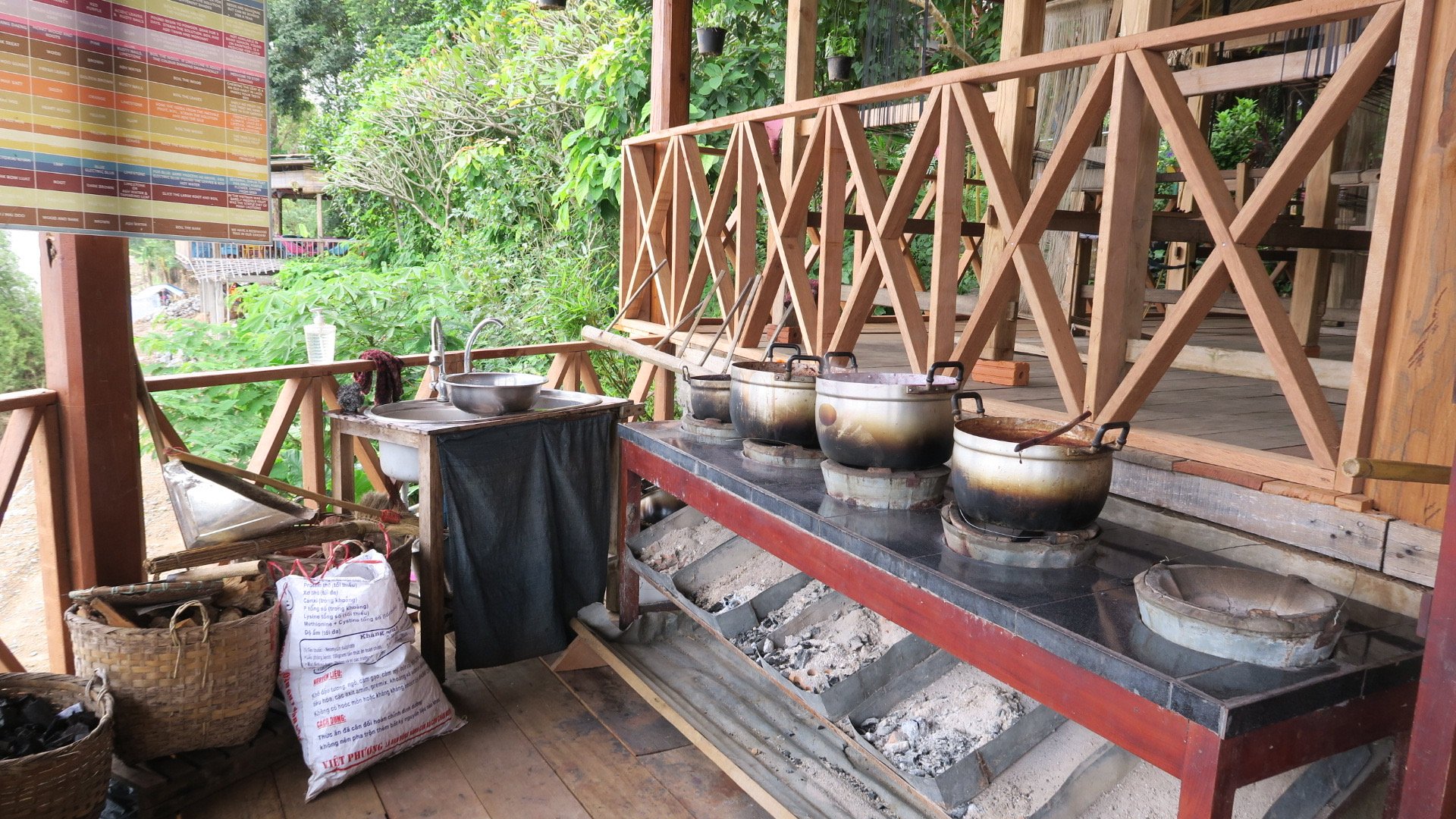
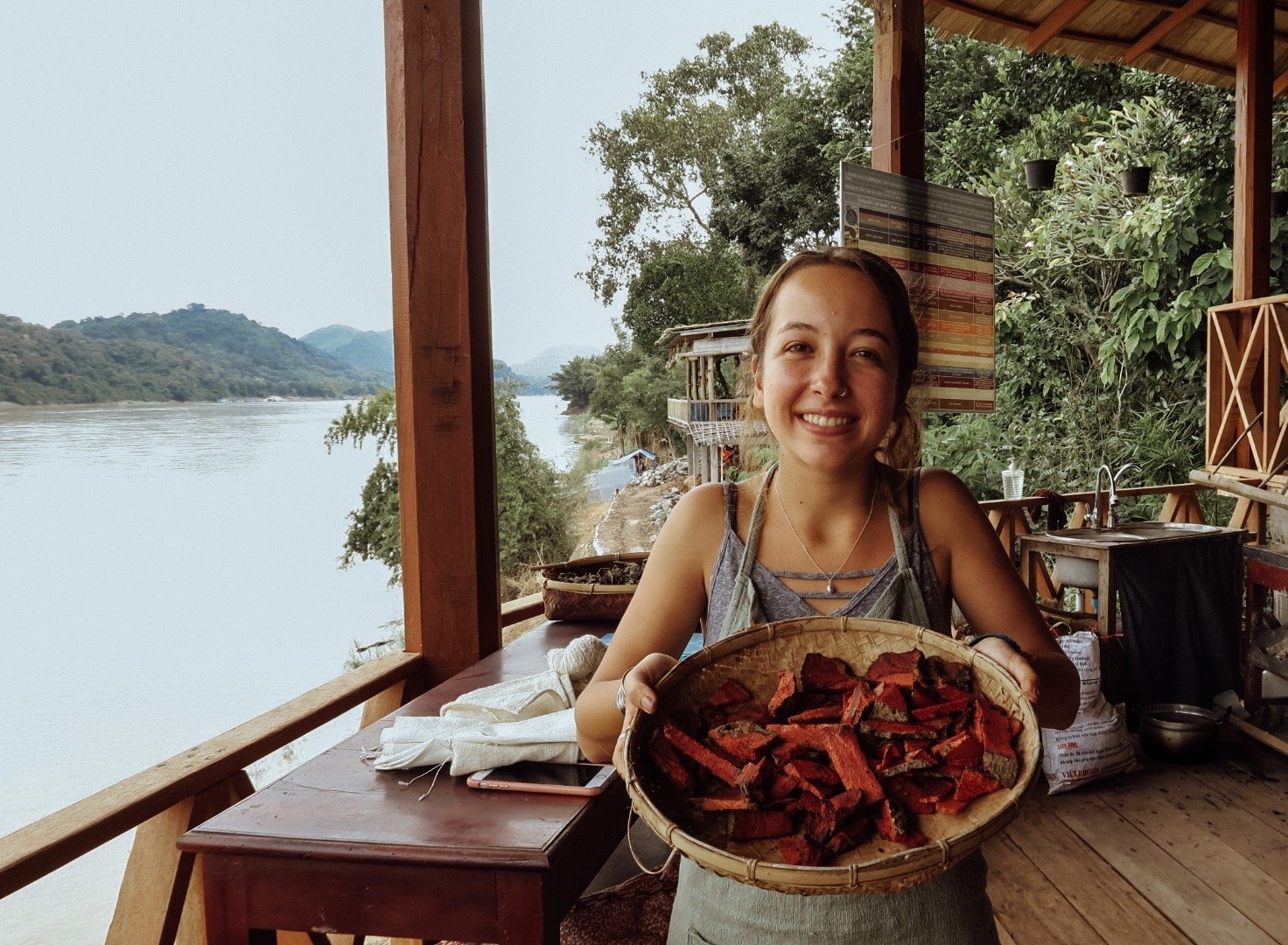

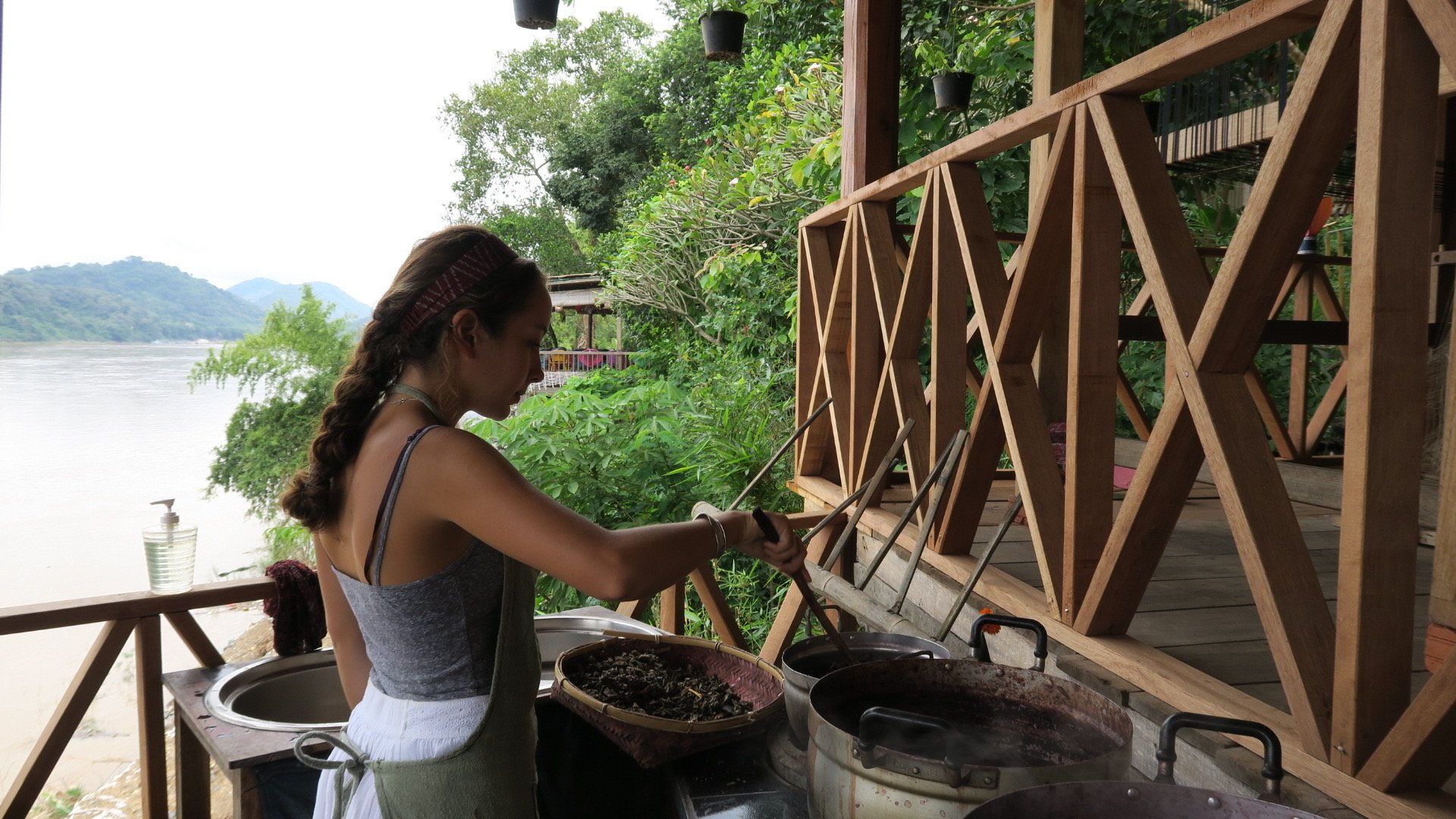
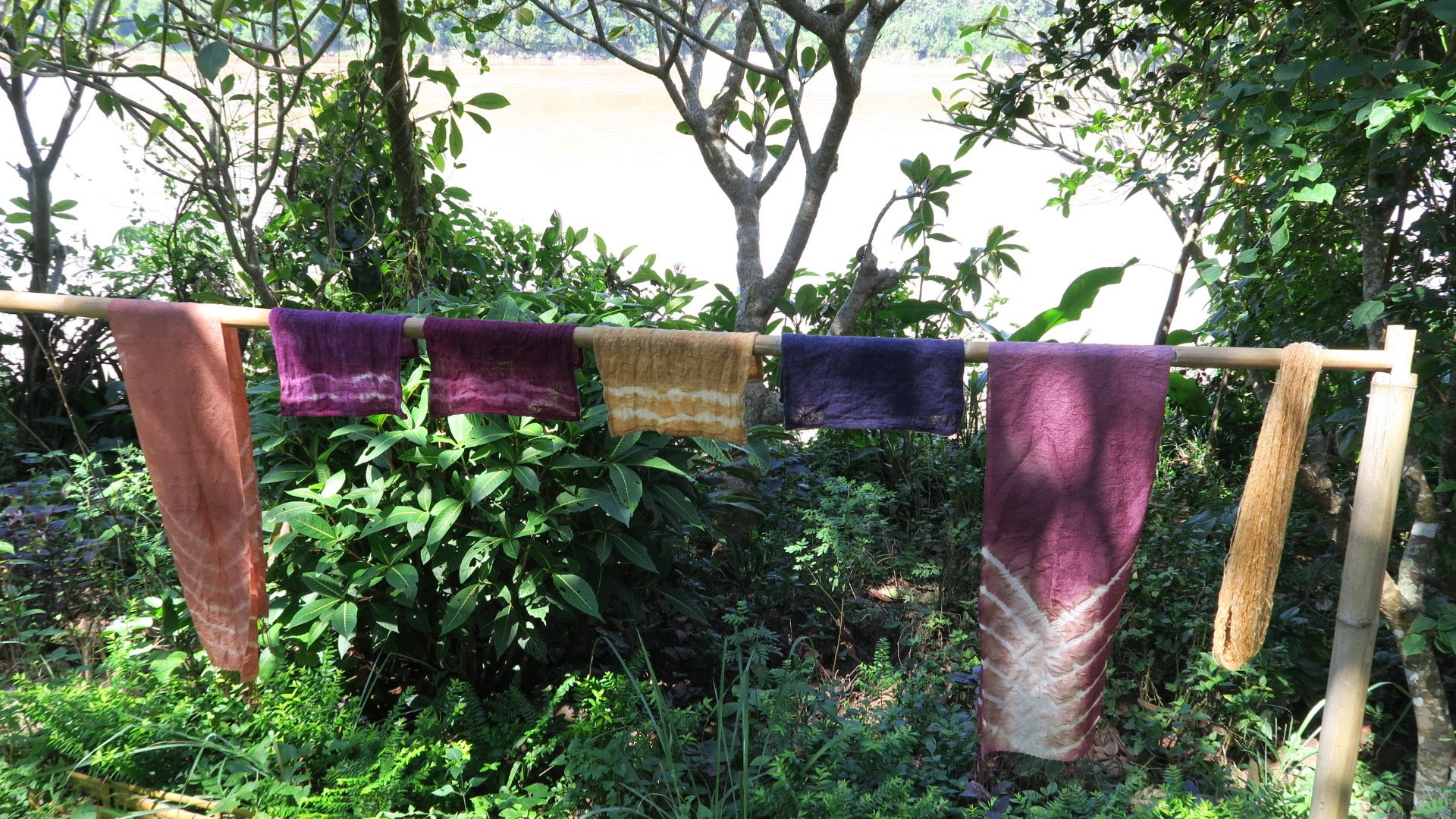
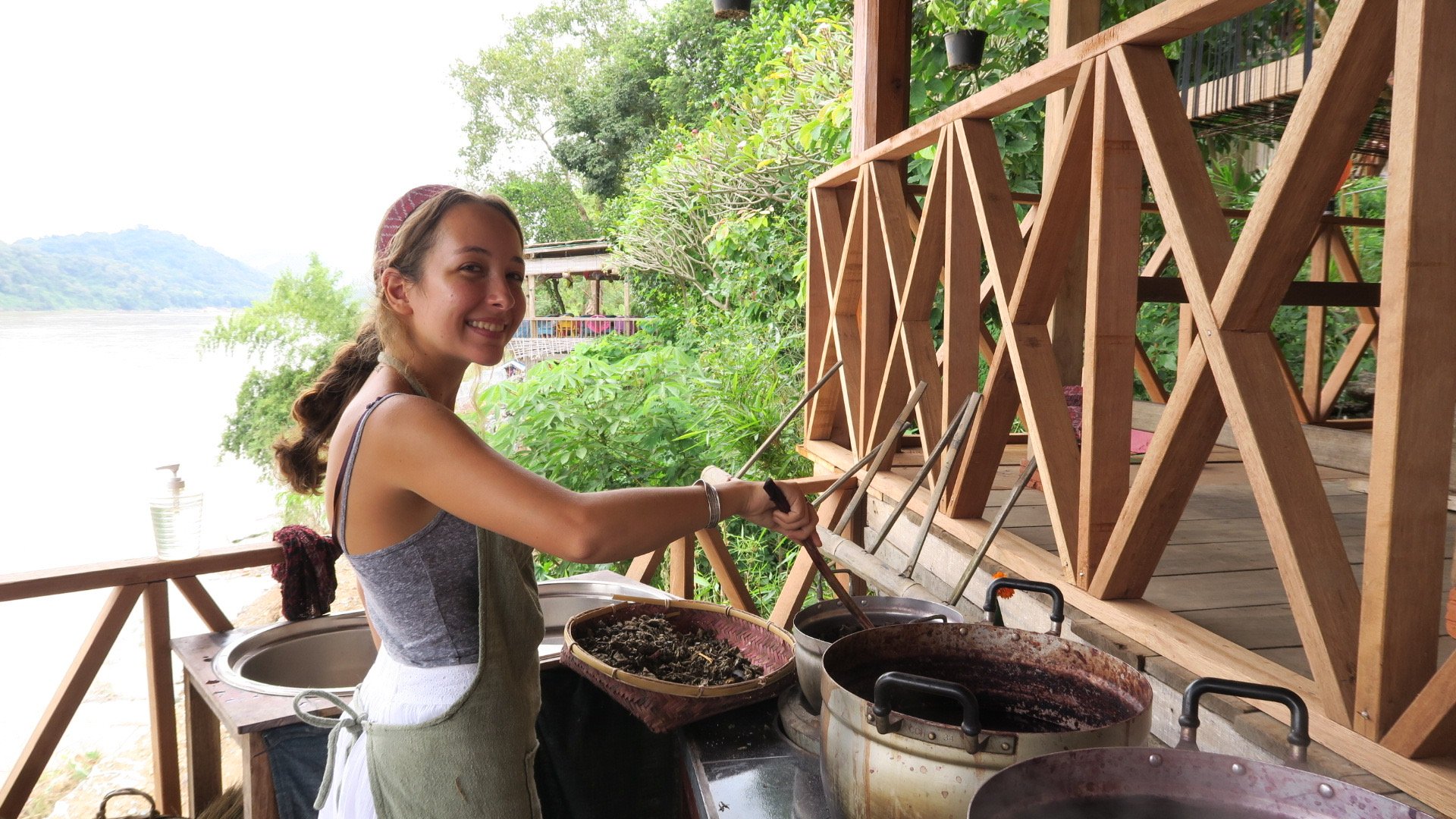
Bamboo Weaving Workshop
Bamboo is a very useful material in Laos and is used daily for different things. There is bamboo soup (delicious), there are musical instruments made from bamboo, there are weapons for hunting made out from bamboo and they are also used for construction! Bamboos can be split in many ways to be used in weaving for baskets, hats, placemats, traps, ceremonial items and even walls or mats. In Laos, the weaving of cloth is done by women but bamboo weaving is done by men. It is a very important skill and similarly to how women can’t get married if they don’t know how to weave a cloth, men can’t get married if they don’t know how to weave with bamboo. At the workshop, I chose to learn how to weave a placemat and my mum made two baskets. The bamboo strips had been dyed using natural dyes.
Three day weaving workshop
The next three days my mum and I did a weaving workshop. The three day workshop offered is usually an ikat workshop. However, after talking to the manager and explaining that I already learnt that technique we decided to try something more advanced. I would be learning about the supplementary weft weaving - both the continuous supplementary weft known in Lao as Kit, and the discontinuous supplementary weft known in Lao as Chok. It was my mum’s first time weaving and she did some Kit as well.
These techniques are practiced by the Tai Kadai ethnic groups in Laos. They have been practiced in Laos since 800AD. Traditionally men would build the looms and weaving equipment (beaters, shuttles, heddles, etc). Now these can be found in local markets.
The Lao Tai Weavers use three patterning techniques:
Interlocking Tapestry Weaving - Nam Lai in Lao : the weaver makes up the pattern as she goes along. The motif is created by adding coloured yarns by hand. Whenever two coloured sections meet, the threads are twisted, interlocking around each other so that they don’t come loose. There are only two heddles (the ones that are used for plain weave) and the weavers are working on the back of the fabric. The weft is entirely the pattern thread. On the back you can see the interlocking of the threads whereas at the front you can’t. This technique is popular in the north of Laos and women use it to make skirts.
Supplementary Weft Weaving: the pattern here is created by adding an extra thread between each row of the background weave. Each time the weaver does a row of background weave she lifts the warps thread and adds the supplementary weft thread. However, when she lifts the warp threads she follows a pattern that has already been created and “saved” in what is called supplementary heddle.
There are two types of supplementary weft weaving: the continuous supplementary weft which is called Kit and the discontinuous supplementary weft which is called Chok.
In Kit, only one colour of thread is used to make the pattern. The pattern thread continues across the width of the fabric, to do this you use a shuttle. In the photos below, you can see the white and blue patterns that run across the whole fabric. They are examples of the Kit technique. In Chok, two or more coloured threads are used to make the pattern. The weaver adds the coloured threads by hand instead of using a shuttle. Of course this is much more time consuming and requires a lot of patience. In the photos below you can see the fuchsia and purple threads that form the pattern using the Chok technique. (More about supplementary weaving and how to create a pattern will be on my next blog post about Laos, where I learnt how to set up a loom at the Houey Hong Vocational Centre)
Ikat weaving
The scarf I wove consists of two main motifs. The white one symbolises family bonds and the purple and fuchsia symbolise protection and strength. Motifs in Lao textiles are deeply symbolic — they can say a lot about the weavers, their ethnic groups, marital status or religion. Some motifs are mythical creatures from folktales and other are inspired by the natural environment like trees, clouds, lightning, birds or flowers.
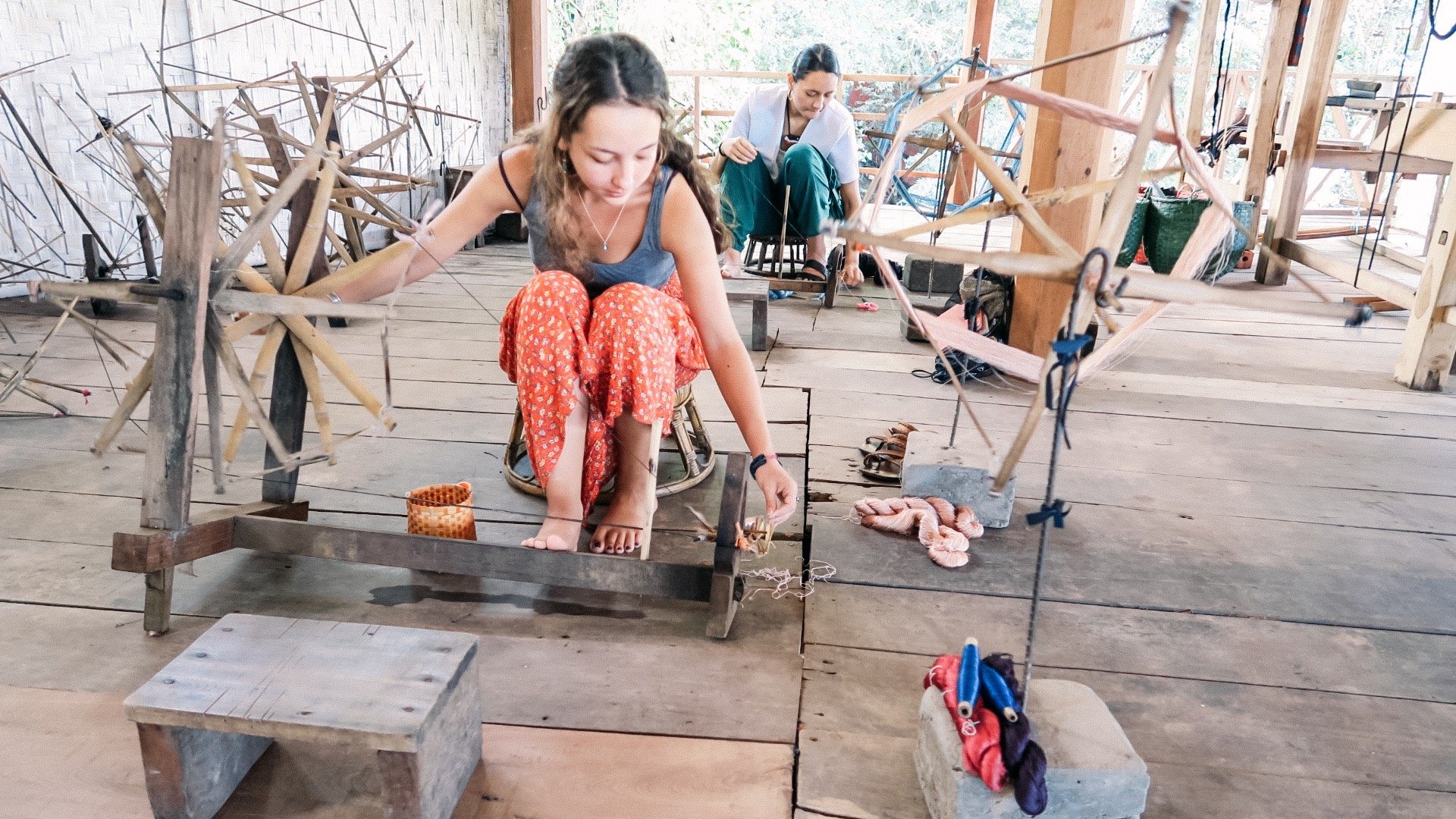


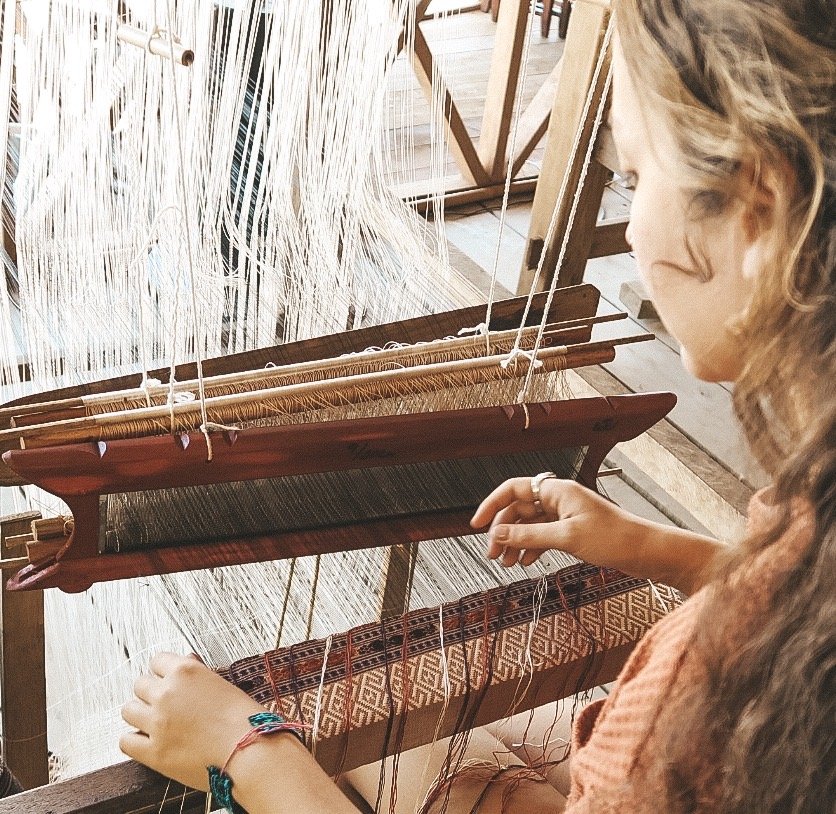
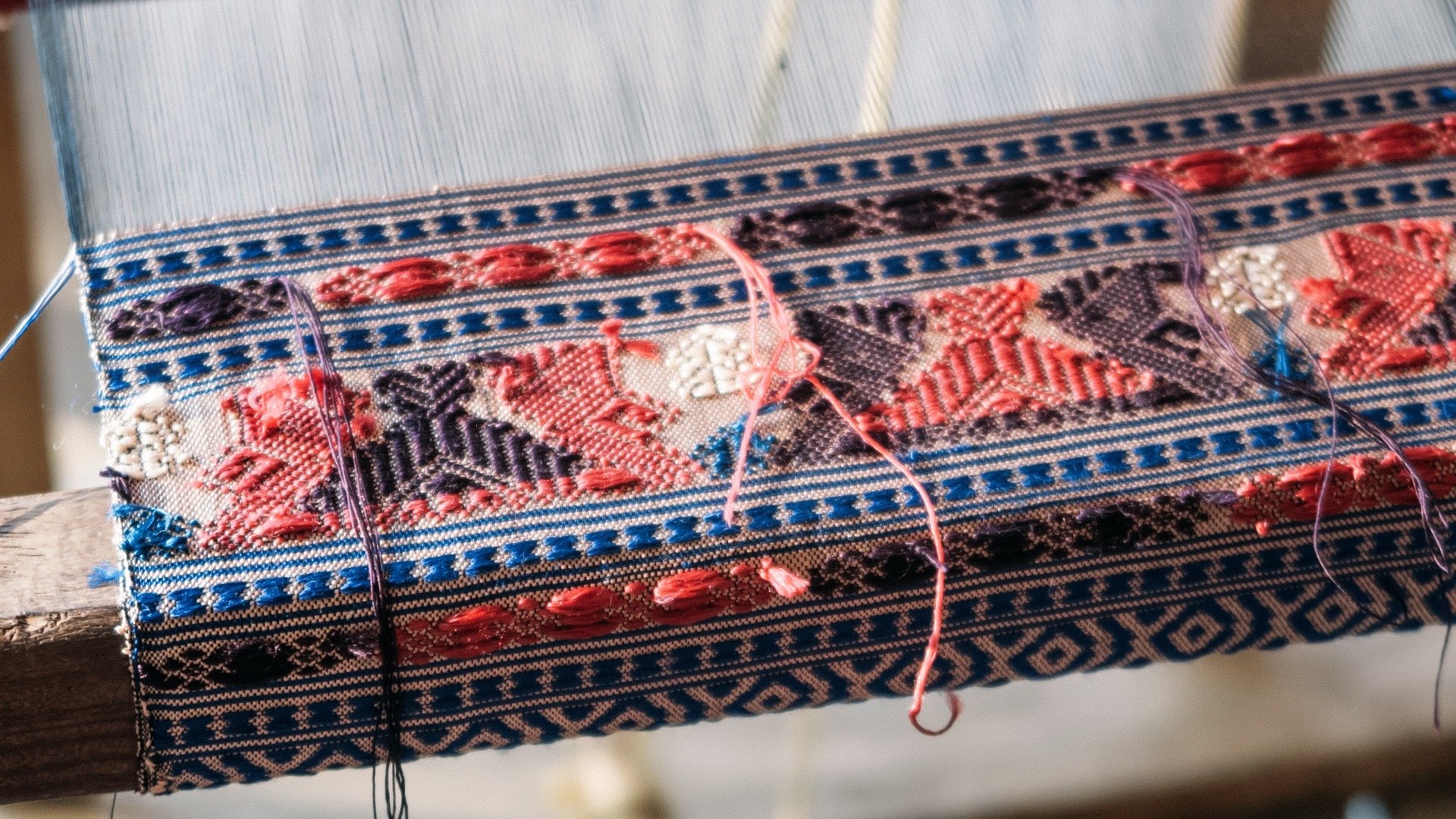
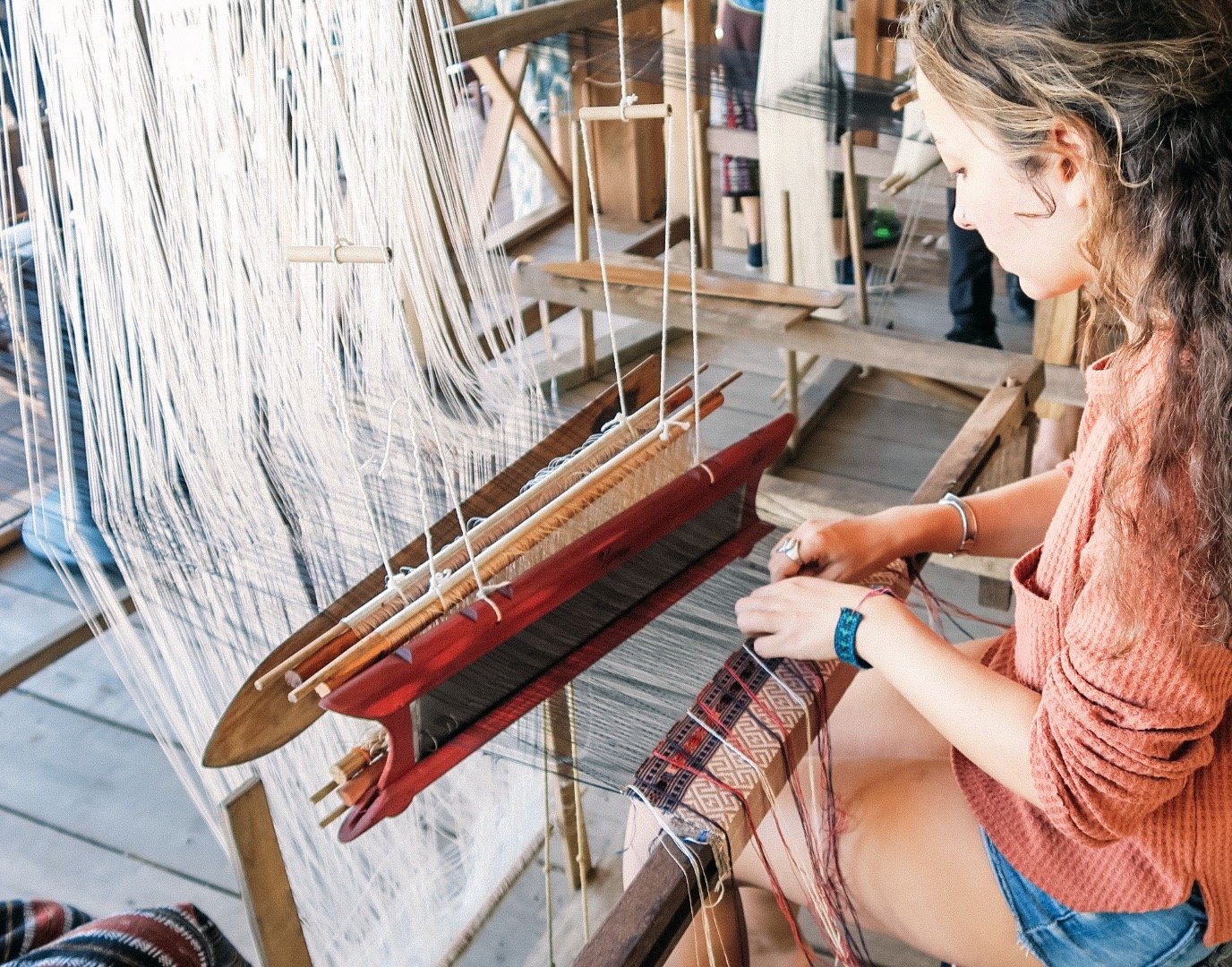
Batik Workshop
The last day at Ock Pop Tok we did a Hmong batik workshop. The Hmong people are thought to originate from Tibet and Mongolia. It is estimated that they make up almost 10% of the Lao population. There are three subgroups: the Hmong Dao or “White”, the Hmong Du or “Blue” and the Hmong Djua or “Striped”. The Hmong people are animist. Spirits of their ancestors and their surrounding environment play a big role in their everyday lives. The Hmong people are well known for their batik. Batik is a resist dye technique. Motifs are drawn with wax and then the cloth is dipped into dye. The batiked motifs resist the dye — and then the cloth is boiled in water in order to remove the wax. This technique originated in Indonesia, however many cultures around the world use this technique. Hmong people use their batiks to make baby carriers, blankets and skirts.
The Hmong don’t have a written language, therefore their textiles become a form of expression. Their motifs are from their surrounding environment and consist of snail shells, ferns, seeds and animal teeth. Traditionally, Hmong people used hemp fabric to batik on. Hemp is a very strong and durable cloth with similar qualities to linen.
Our teacher was called Mae Thao Zu Zong. She is the only Hmong batik artist in Luang Prabang. She showed us four different traditional patterns to choose from and re-create. We smoothed our hemp cloth with a stone and scored in a grid, to make it easier for drawing the symmetrical patterns. The wax used was bees’ wax which is found in the forests of Laos. We heated it in a small metal pot and mixed it with indigo paste. This is done because the wax becomes coloured and it’s easier to see on the cloth. To draw with, we used bamboo pens with metal triangular nibs on the top.
We finished drawing our patterns and then we dipped them into indigo. we only dipped them into indigo once so the blue is very light. However, for very dark shades of blue, like the batik skirts, the hemp is usually dipped around 20 times over a period of 2 weeks.
After our batik workshop, we decided to hike up mount Phousi to see the sunset. The view was beautiful and I definitely recommend going up and seeing Luang Prabang from the top.
Finally, here are some photos from Fibre2Fabric, Lao Heritage Textile Collection, found in the Ock Pop Tok Living Craft centre. This collection includes more than 1000 Lao textiles. It began in order to protect the heritage textiles in Laos. Currently, half of the ethnic groups in Laos are represented in this collection. Here are some photos:
I loved both Vientiane and Luang Prabang for different reasons. They are both places I want to visit again. I know there is a lot more to learn about textile techniques, traditions, symbolism and history in Laos. It will definitely be on my list of places to visit in the near future.
Next blog post will be about Hanoi and Halong Bay in Vietnam. Until then have a lovely week!
xxx Christiana




